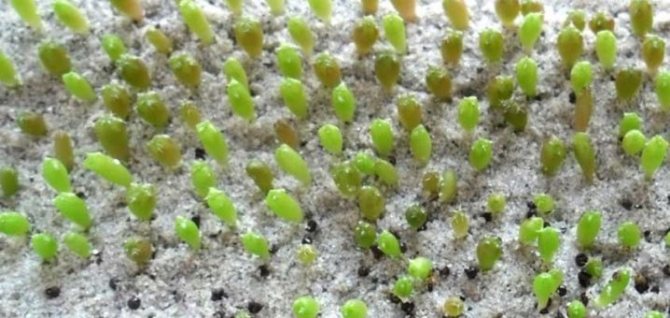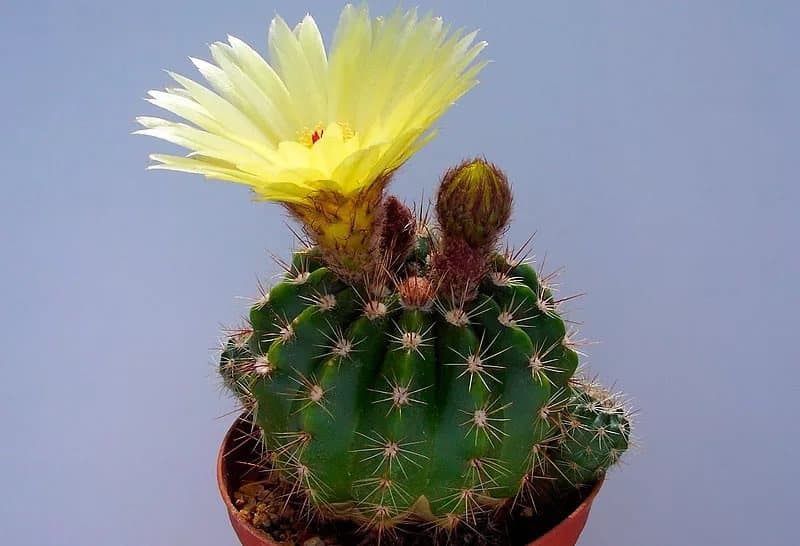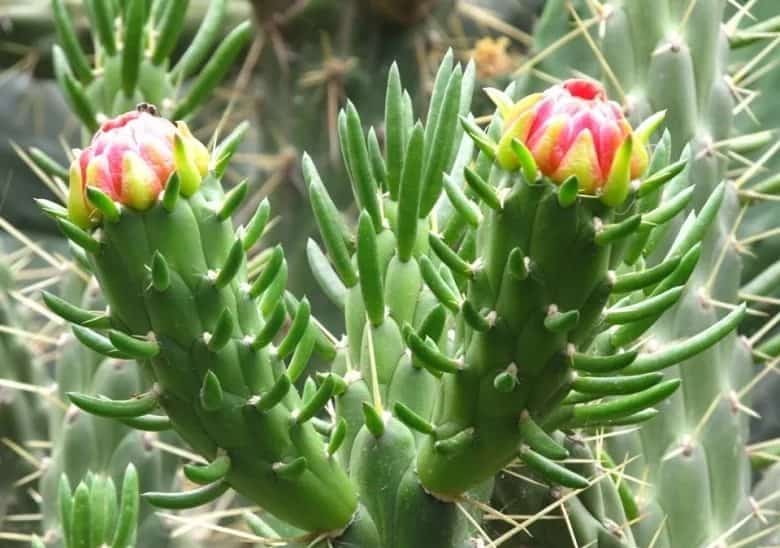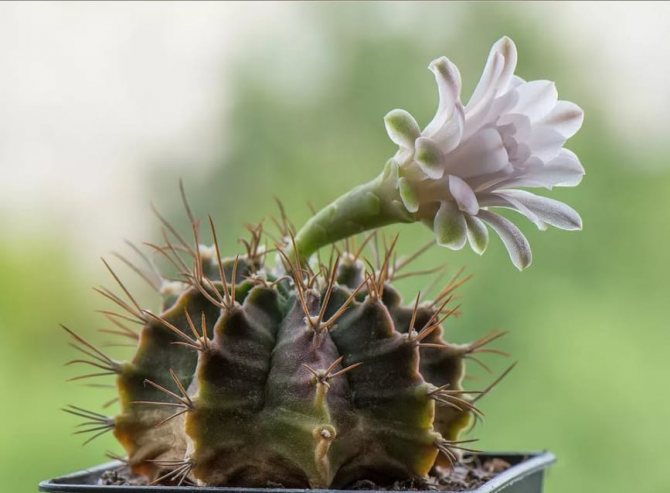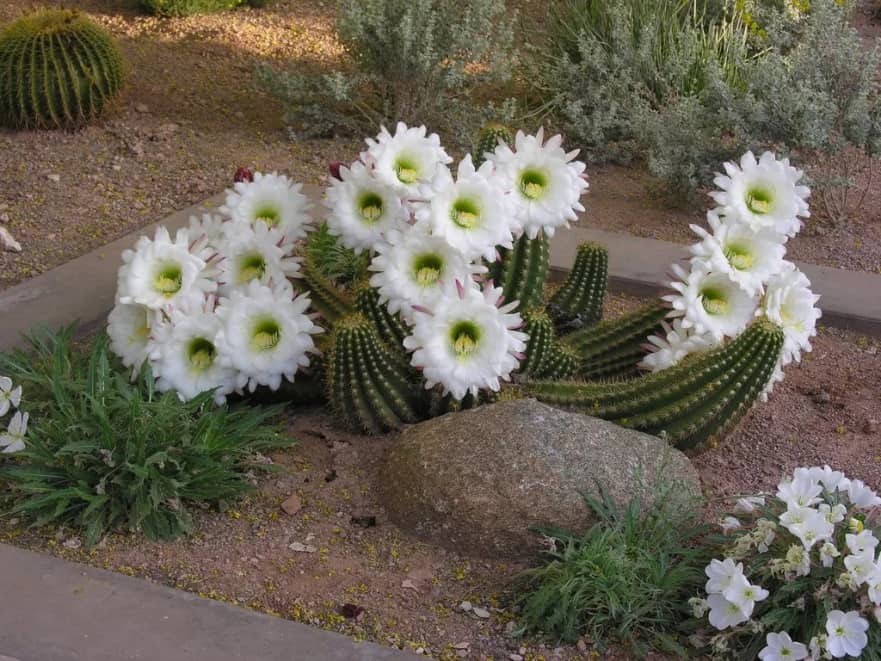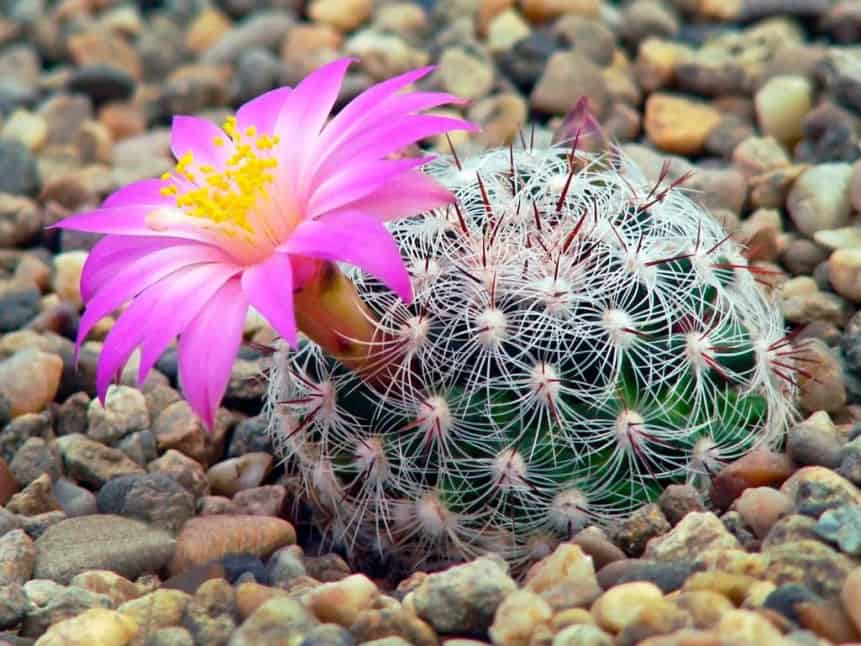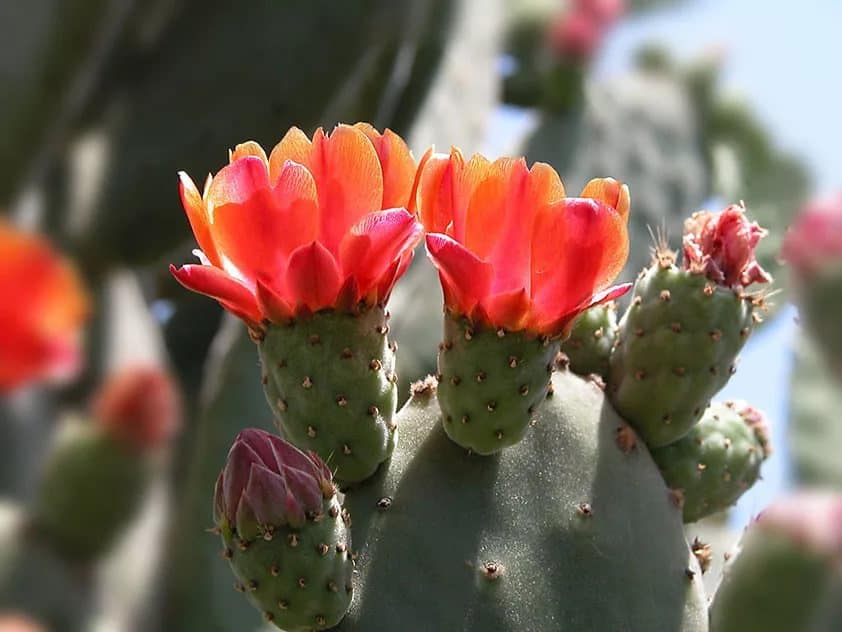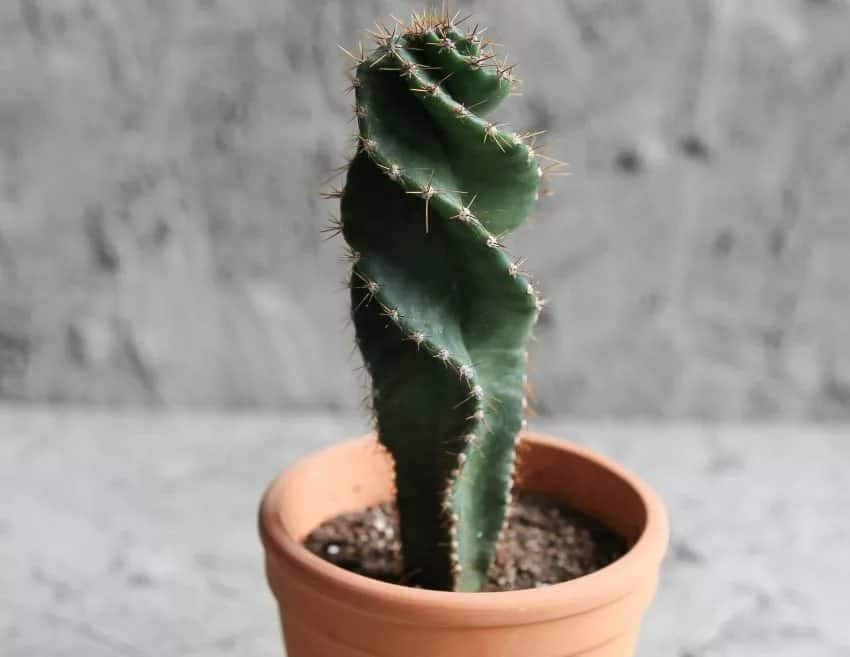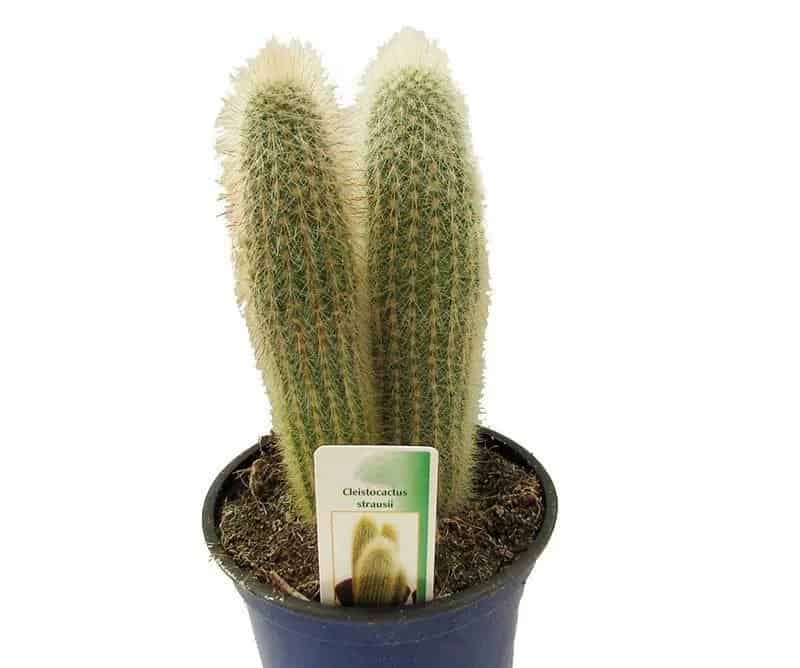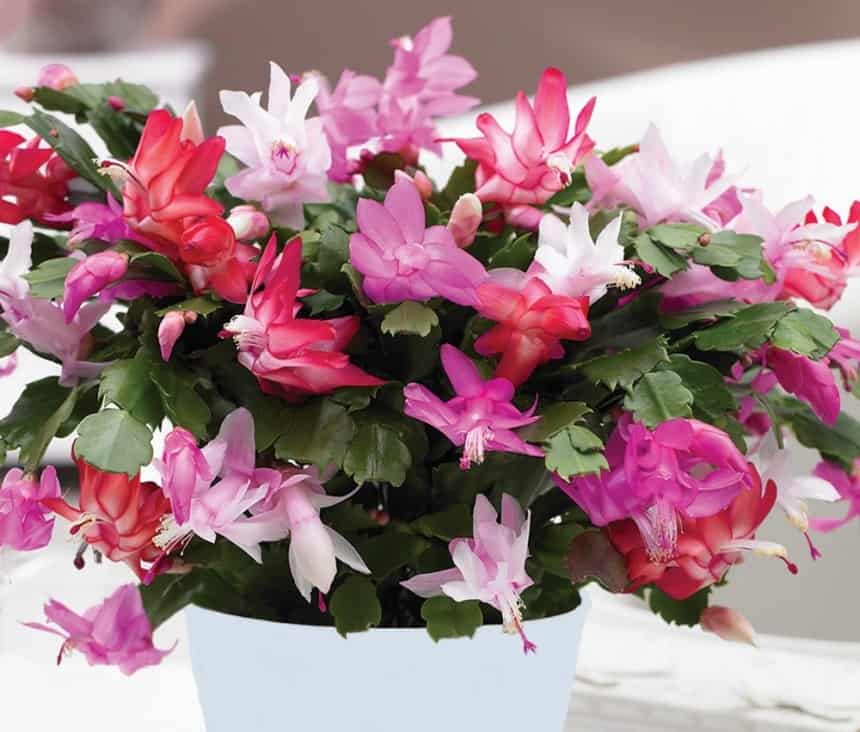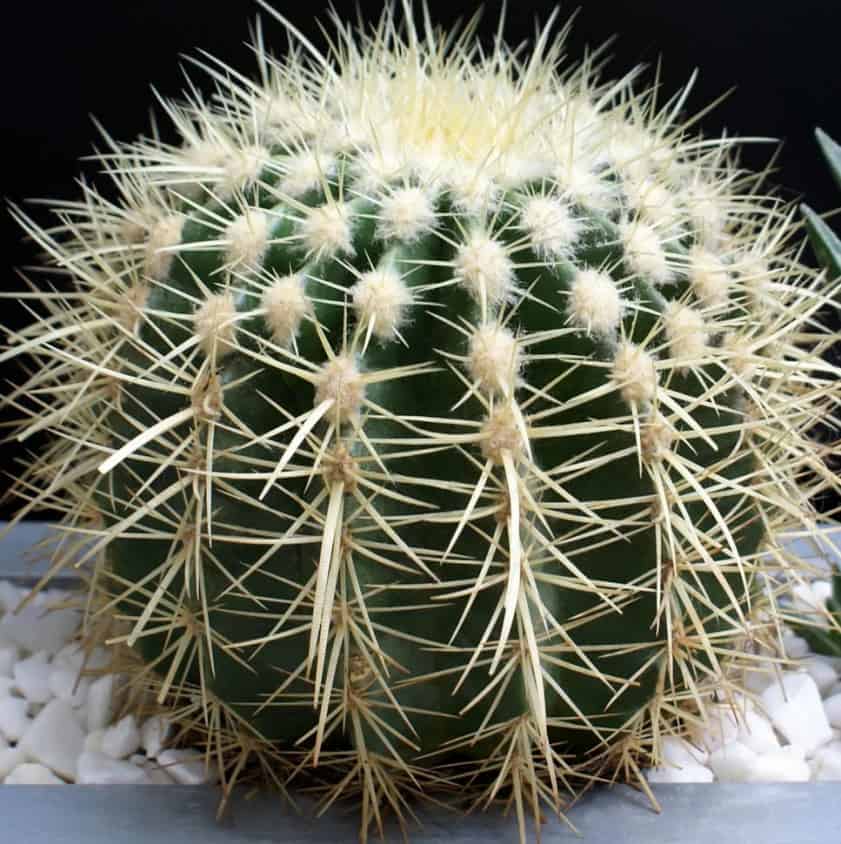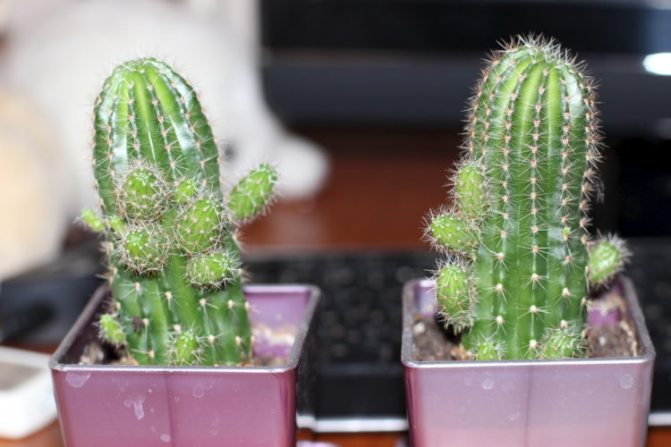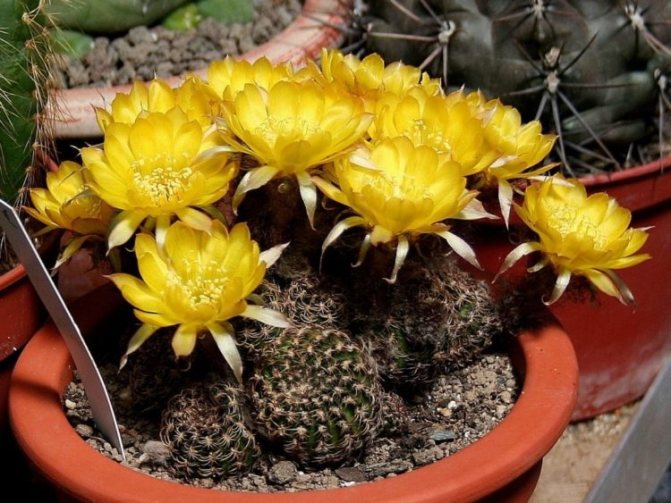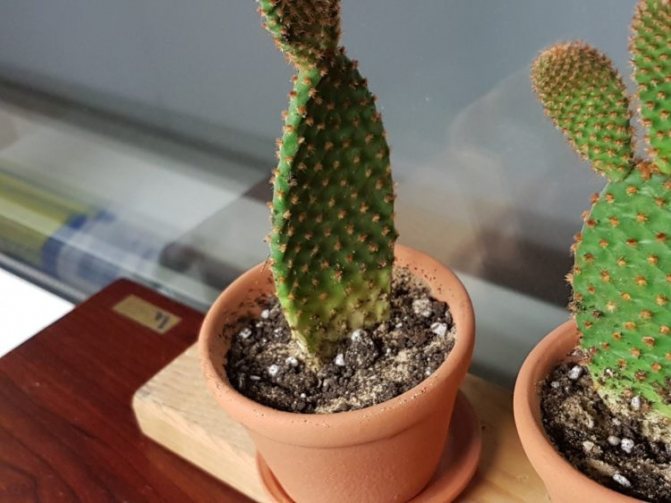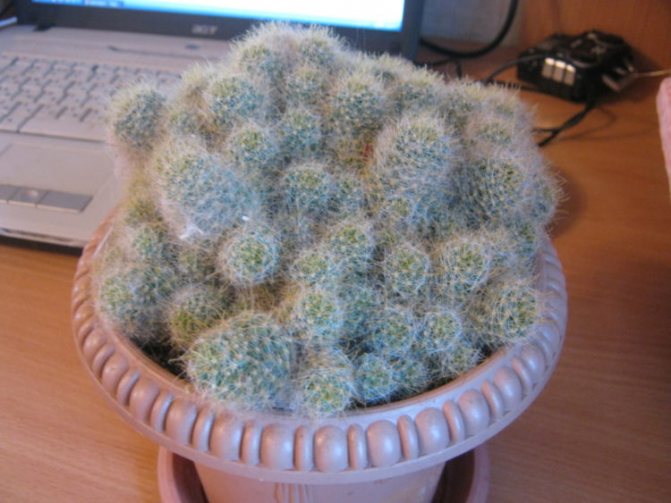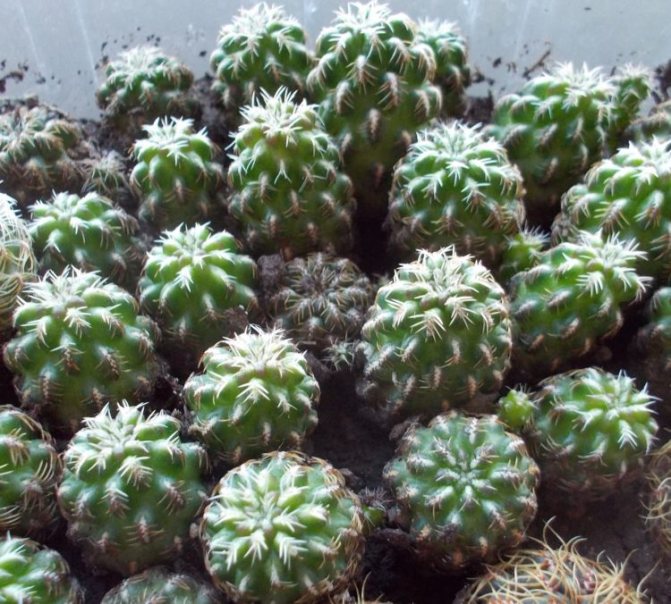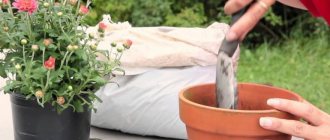
It is not difficult to ensure the reproduction of cacti at home, you just need to know the rules and follow the planting technique. We will learn about this from the article.
- How do they reproduce
Reproduction by children at home
Step-by-step instructions for rooting a baby
- Step-by-step instructions for grafting
- Step-by-step propagation of the cuttings in the substrate
- Sowing step-by-step instructions
- Step-by-step instructions for plant grafting
Can this be done?
It is possible to prune cacti, and in some cases it is simply necessary.
It may be necessary to prune and re-root a cactus for various reasons, but most often this happens in cases where it is necessary:
- The plant starts to rot.
- The shape is changing, the plant is strongly distorted.
- Strongly grown and extended.
Cacti get sick due to inept care, pests or inappropriate regimen... Warm hibernation, excessive watering or lack of light can seriously weaken the plant, reducing its ability to resist disease and pests. In order to prevent this from happening, we suggest reading about how to properly water this plant and what place is better to choose for placing a green friend.
Rotting can begin due to:
- Overflow.
- Unsuitable soil (you can find all the details on the choice of soil here).
- Too large a pot in which water stagnates (how to choose a pot for a cactus?).
- Due to fungal and bacterial infections.
Where is the best place to place the plants
So, before we talk about how to plant a cactus without roots with children, we first find out in what place it is necessary to place dishes with plants. Experienced growers divide thorny "friends" into several groups:
- Forest varieties.
- Desert varieties.
The latter prefer an abundance of sunlight, so they are best placed on windows facing the South side. But forest cacti do not like too bright sun, exposure to sunlight can cause burns on them. They are best placed on window sills with windows facing the North or East side. In no case should you place flower pots in strong shade, because a lack of sunlight will lead to their deformation and even death. And if the plant is flowering, then in the shade it will never bloom. With the onset of a warm pore, cacti can be taken out onto the balcony, they will grow very well in the fresh air. Now let's talk about when the cactus sprout should be planted in the pot.
Which species are most needed?
What types of cacti require pruning most often? Most often, you have to prune plants of the following varieties:
Gymnokalycium Mikhanovich
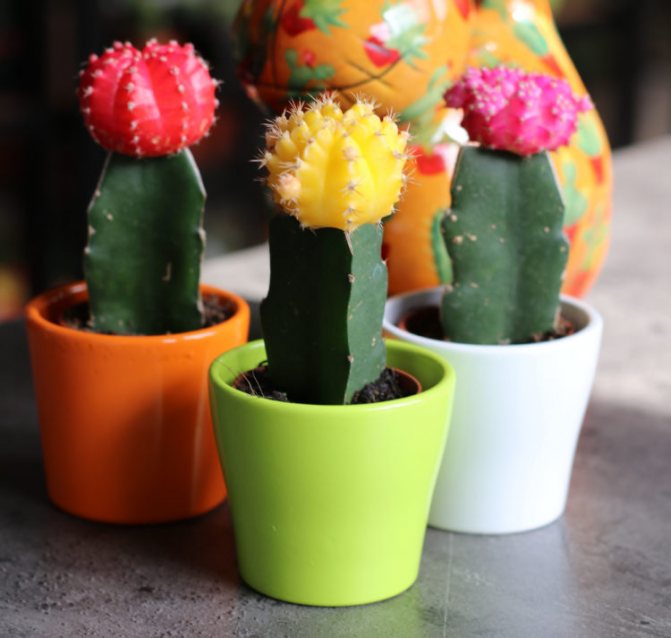

It has a thick, elongated stem, covered with triangular ribs, brown or grayish-green in color.
Echinocactus
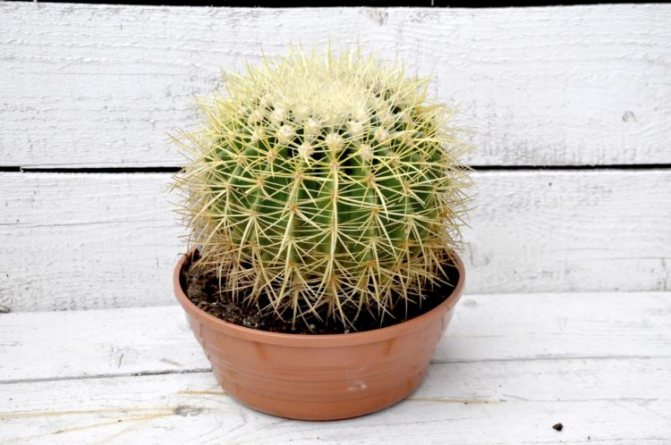

Globular plant, growing slowly, unpretentious.
Cleistocactus Strauss
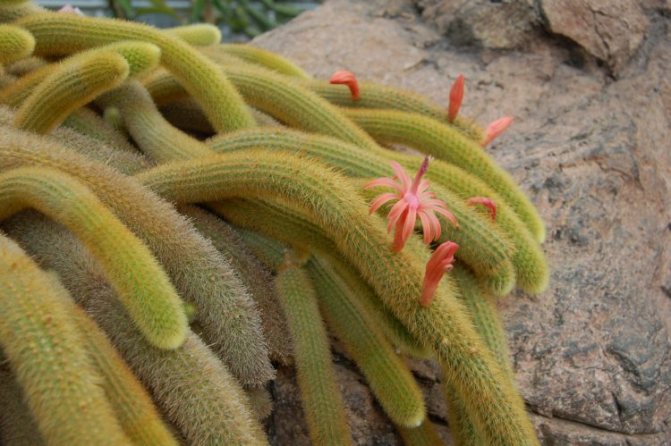

A horizontal columnar plant that grows up to 1 m in height. A feature of the cactus is the closed tubular flowers..
Prickly pear
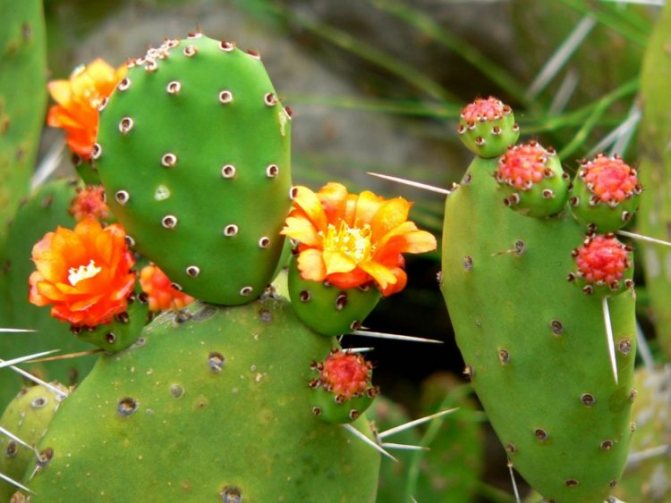

It grows up to 30 cm, has many small, very sharp spines.
Whitening Trichocereus
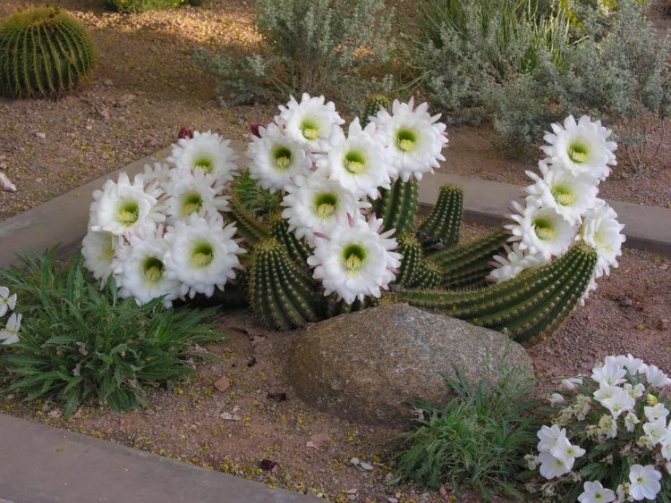

The stem grows vertically, or at a slight slope. Differs in large white funnel-shaped flowers.
Mammillaria
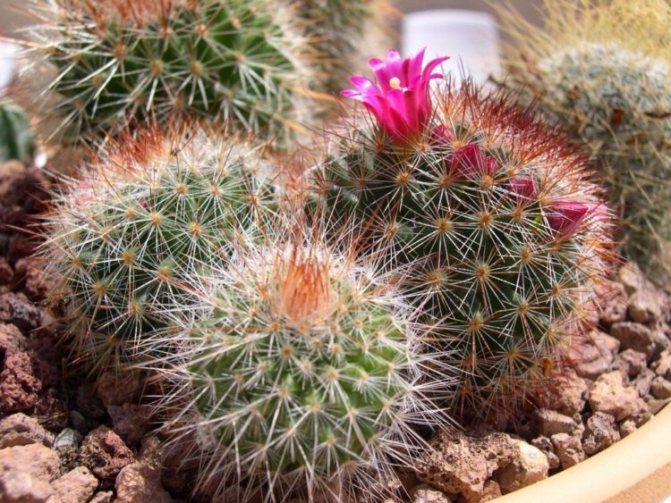

Mammillaria is covered with long soft spines, has a cylindrical or oval shape.
Notocactus Otto
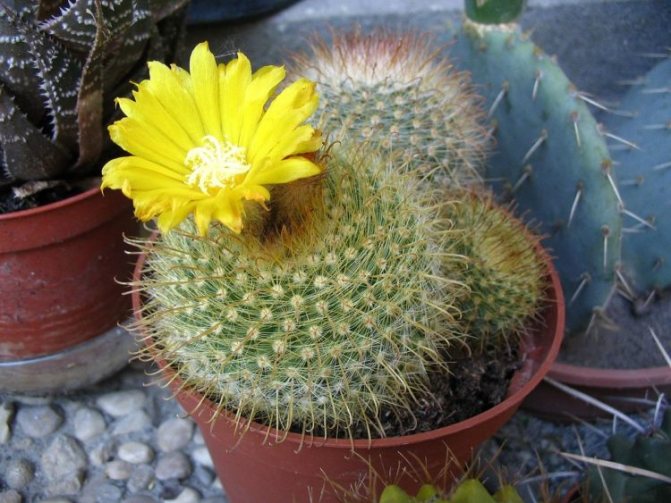

It has a thick stem with pronounced edges, on which hard spines are located.
Cylindropuntium
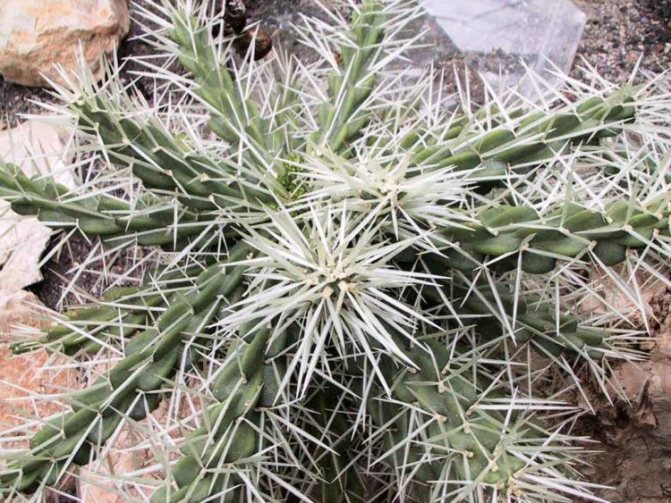

A branched cactus, the stem consists of many elongated segments. Grows up to 1-2 meters at home.
Cereus
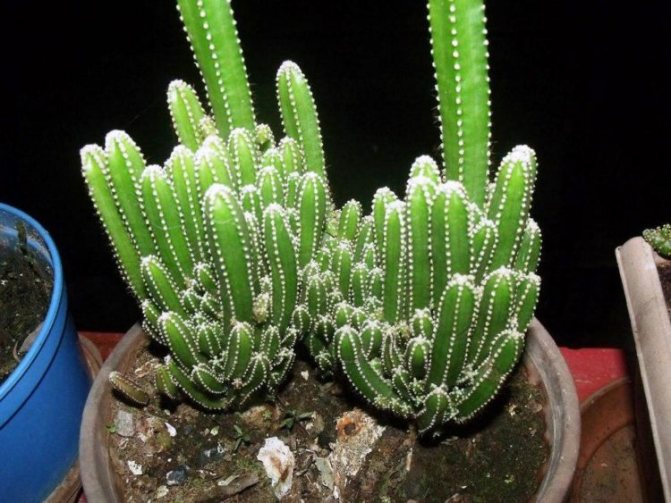

A tree-like cactus with a massive stem and many processes.
Blooming cactus
Epiphyllum: home care and breeding examples
Proper care of a cactus is the key to abundant flowering. The reasons why succulents do not bloom at all or do it rarely are different: diseases; too high or low temperature of the environment; excessive watering and high humidity for drought-resistant cacti; the air in the room where the tropical ones stand is dry. Frequent rearrangements of pots are also harmful.
If these problems are controlled and properly fed exotics, they will surely please with long and abundant flowering. For example, the bright pink, purple or red flowers of aporocactus will adorn its long lashes from February to June.
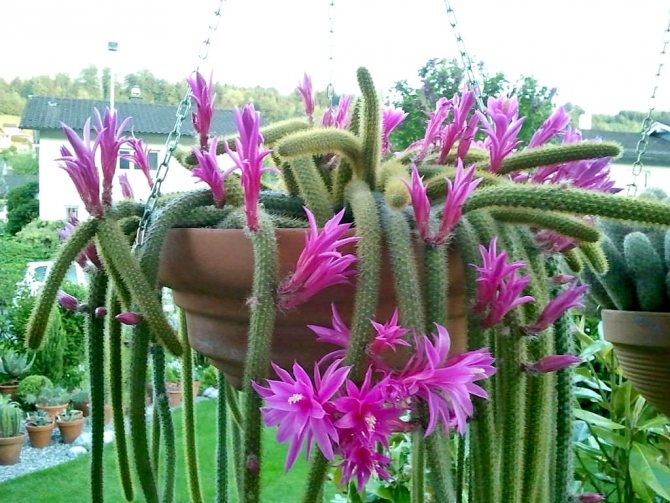

Aporocactus is unusually picturesque
When and how often to produce?
The most difficult rooting of cacti takes place in autumn and winter.when the plant is in a state of stagnation. But unfortunately, it is during these seasons that the plant's immunity decreases, and it is attacked by fungal and bacterial infections. Most often, the situation develops in such a way that pruning followed by rooting is the only way to save the plant from death.
If circumstances do not force you to immediately save the thorny succulent by circumcision, you should wait until spring or summer. Cuttings cut this season will take root better and the mother plant will survive.
When is the procedure needed?
You can prune cactus, and in some situations this is the only way to save an exotic plant. Most often, pruning and rerooting is carried out in the following cases:
- Succulent plants are affected by rot.
- The cactus is significantly deformed, a strong skew is noticeable.
- He began to grow intensively, stretch out.
Living in extreme conditions, the plants have acquired strong immunity. However, once in unfamiliar conditions, without receiving proper care, they become vulnerable to pathogenic flora and pest attacks. Wintering in a warm place, excessive soil moisture, lack of lighting weaken the succulent, reduce its ability to resist parasites and pathogens.
The cactus begins to rot for the following reasons:
- Due to waterlogging of the soil.
- Flower growth in an unsuitable soil mixture - too dense, oily, retaining moisture.
- Too spacious container - water stagnates in it.
- As a result of plant infection with pathogenic fungi or bacteria.
To prevent the spread of putrefactive processes, it is recommended to cut the succulent, otherwise the specimen will die. In addition, this method can be used to correct the shape of a cactus, but only if there are no other options.
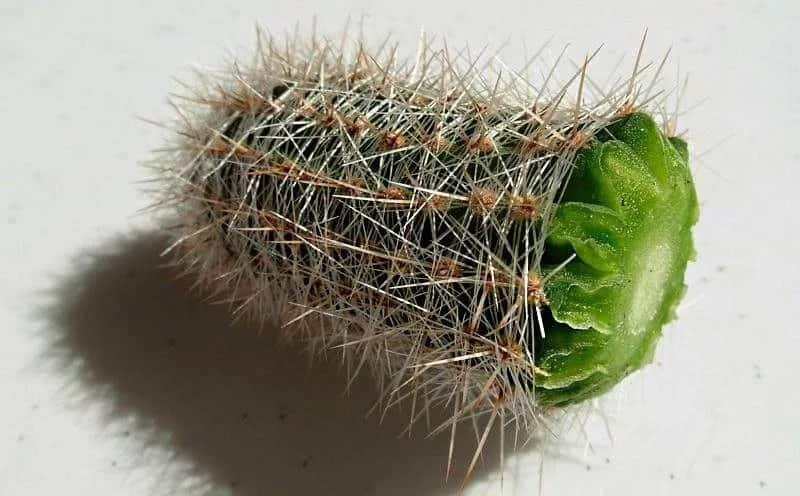

How do you know when cropping is needed?
There are a number of external signs that make it possible to understand if the top of the plant can be cut.:
- The skin turned yellow and stopped shining.
- The plant shriveled up.
- The cactus squinted to one side.
- Spots appeared on the trunk (wet, dry, different in color and structure from the rest of the plant).
- Stopping growth and subsidence during the growing season.
- The plant has grown too long, heavy and threatens to overturn the pot.
- It rests against a shelf, a window sill, there is not enough space for it, it is not possible to transfer it to another.
What happens if you don't trim on time?
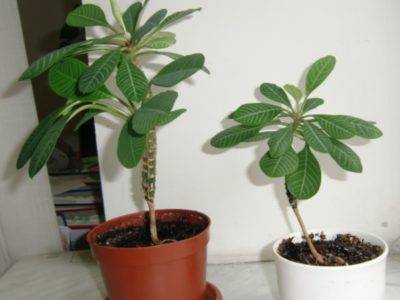

If you do not cut the plant, then the bush can grow very tall and its shape will begin to deteriorate.
This will cause inconvenience in his courtship. If he is on your windowsill, then he will not have enough space there.
As well as the plant needs hygienic pruning as needed.
It is necessary to cut off all damaged and ailing shoots in order to preserve the flower and prevent the development of diseases.
Step-by-step instruction
Before you start pruning a cactus, prepare everything you need for this process.... You will need a sharp, thin knife (you can use a clerical one), an alcohol solution to disinfect the instrument, charcoal powder, a pot and soil for the plant. Be sure to prepare a thick towel or plastic tweezers to help you grip the barbed trunk while you process.
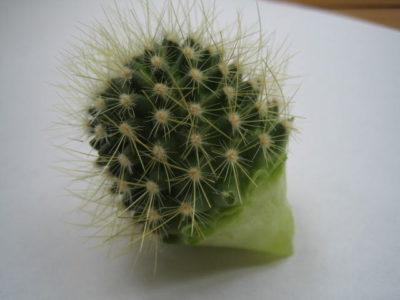

The following outline describes how to prune a succulent plant at home:
- Select the mother plant to be pruned. If your cactus is longer than 15 cm, start pruning right from the top of the head. If the plant is small, remove it from the ground beforehand - this will make it easier to neatly make a cut.
- Disinfect the knife, and, grabbing the plant, carefully cut off the desired part. The larger the resulting stalk, the better.
- Examine the cut - the tissue should be healthy, without lesions.
- Sharpen the cactus into a pencil shape. Do not sharpen too sharply, this is not necessary. This is done due to the fact that when drying, the protruding middle will be pulled inward.
How to properly prune a cactus
Take a cut from an old plant. If the cactus is long enough (15 cm or more), it can be cut off from the crown. If the plant is not very tall, remove it from the ground to make it easier and more convenient to cut off the top. Now take a sharp knife or blade and with a firm movement cut off the top of the cactus (about 6-8 cm). Too small a cut should not be made, since the plant can simply dry out or rot. But you don't need to get carried away with huge "cucumbers" either. Choose a medium size.
File your slice like a sharpened pencil. The fact is that when dry, soft tissues will begin to be drawn into the fleshy part. If left flat, it can easily look like a reverse funnel after a week. Getting roots from such a surface by burying it in the soil is extremely problematic. That is why the edges of the cactus must be sharpened.
With the same sharp knife you used to cut, carefully trim the edges to make the cactus look like a pencil. It's worth getting carried away. A "peg" of 1.5-2 cm is quite enough. Remember the proportions. If you process 2/3 of your cut for a pencil and leave 1/3 as it was, the chances of rooting are very slim. The optimum is the cut-to-plant ratio in a 1: 3 ratio.
Dry your miracle within a week. Do not be afraid that during this time the cactus will die without water and soil. Drying is a prerequisite for successful rooting. Leave the cactus on a plate or in any other container so that the wet cut dries up and is pulled in a little.
If you've done everything right, the pointed part should be almost flush with the original edges of your cut. Now the cactus can be planted in the substrate. Pour drainage into the pot, top with cactus soil, and then a small layer of sand. Carefully screw your pencil into the center. Now all that remains is to regularly moisten the soil in the pot and wait for rooting.
2013-01-10
news-regions.rf
Hello! Recently I took a new cactus from my parents, but due to improper care it stretched out and acquired an irregular shape ... I attach a photo. Tell me what to do and is it possible to fix it? or let it grow as it grows.
Love is perhaps Strauss's cleistocactus. Strongly stretched and bent, most likely from a lack of lighting. Desert cacti need maximum light all year round. Rejuvenate cacti by cuttings: cut off the top of the head no more than 10 cm in height, dry the cut for a week in a VERTICAL STATE in a dark place. After that, they are planted in loose soil, slightly pressing the cut from it. Place the cactus pot in a bright place, but the hot sun should not fall on the cutting. The first time they spray the soil, DO NOT WATER! otherwise the cactus will rot.
Yes, I understand that from a lack of lighting ... I just would like to transform and leave the lower thick part, and not the upper scary area ....
Love, if you root the crown of 5 cm, then with good care you will grow a beautiful cactus. The upper part can be cut off and the lower one left, usually this is done to get babies - young cactus that appear at the cut site or next to it. But I don’t know if this type of cactus is "baby".
It is no longer possible to restore the natural beauty of this particular adult cactus without surgical intervention.
Valentina, thank you for your participation! Tell me, it turns out that I need to cut off, well, suppose, first, at one of the processes, the top of 5 centimeters and try to root, and just cut off the lower part as much as I want, or are there some rules too? and what to do with the slice? And what time of year is it better to do this?
Love, of course, experiment so far with one of the cacti. Cut off the top of the head, but no more than 10 cm in height, and then further, as I described above. It is better to shorten the mother plant remaining in the pot, sprinkle the cut with activated charcoal or charcoal powder so that the infection does not get. The cut, of course, will dry out and become ugly. Most cacti in this place after some time (not immediately) have babies, maybe yours will?
We cut off the top of the head like this:
Love, cut off the top of the head and shorten it as much as you like, cut the intermediate part into cuttings of 10 cm, sharpen the lower cut like a pencil, the upper one is even, sprinkle it with charcoal. And plant in the same way as the top of the head, as Valentina described. Watering until the roots appear, it is better to do it from the bottom, from the pallet, and it is very sparse, so that only the bottom of the soil gets wet, then the roots will reach for the water and will soon grow back. The soil is sterile and with a high content of sand, it is convenient to plant in transparent disposable 100 ml. cups with slots at the bottom, then the roots are visible. And in turn, not all at once.
Natalia, thank you very much!
I would also like to know, where I have met, that the earth is sprinkled with some white stones in pots, it looks very beautiful, I would like to do the same, but I do not know what it is and is it harmful to flowers?
And at what time is it better to do this cuttings? in the spring?
When rotting, the cactus is cut to healthy tissue (the cut should not show red and yellowish tissues - everything should be white and pale green). The knife should be disinfected after each cut. The incision can be sprinkled with crushed coal (burn and rub a match in your fingers). After that, the healthy part should be dried. The time depends on the size of the cactus and can be up to a month. I think a week will be enough. During drying, the cutting should not be in direct sunlight. Optimally, if the cutting will be dried vertically (cacti give roots exactly downward). This can be achieved either by hanging the cactus on a rope / string, or by sticking it into an empty vessel.
After drying, the cactus must be rooted. This can be done in several ways: 1. In clean sand. A few days dry, then minimal watering, preferably "from below". (instead of sand, you can use perlite or vermiculite - bought in flower shops) 2.Earth is poured into the bottom of the pot, it spills well, dry sand is poured on top. The cactus is stuck in the sand (does not touch the ground). 3. Over the water. Water is poured into the vessel. The cactus is fixed in such a way as not to be in the water (1-2 cm above the water level).
After the cactus has grown roots, it can be transplanted into a permanent pot, cactus potting soil. (I recommend pouring sand, perlite / vermiculite into the prepared soil mixture to make it more crumbly and breathable.)
Be careful when working with this cactus, try not to touch your hands, use tweezers and folded paper several times. Opuntia have glochidia - very small spines shaped like a harpoon. They are easily separated from the plant and dig into the skin, they cannot be pulled out of the skin because of the shape, they come out after a while with sealers.
Uff. This is what I dashed off a treatise
forum.
What if the plant dies after the procedure?
It is carried out according to the same scheme as the previous one - the plant is cut off with a clean knife, sharpened in the form of a pencil and laid out to dry.
Thoroughly clean the affected tissue when trimming... Even a small focus of infection will lead to a second disease.
If you take into account all the factors affecting the development of a cactus, then you will ensure that the plant will regularly delight you with its flowering.
If you find an error, please select a piece of text and press Ctrl + Enter.
Caring for this representative of the flora usually does not cause much trouble, but special attention should be paid to the transplant. It is important to know how to correctly transplant a cactus into another pot in a room, because mistakes will lead to a violation of its normal growth and development, and in some cases even death.
It is necessary to choose the right moment for transplanting, the optimal capacity and soil mixture, prepare the plant for the procedure itself and take into account its features during work, while not forgetting about your own safety. Also, the plant needs to create conditions after transplanting so that it can comfortably endure stress.
Planting soil
So, we continue to talk about how to properly plant a cactus in a pot yourself. The rooting of the flower is carried out directly in the ground. Land for planting can be prepared by yourself or you can buy ready-made. If you decide to purchase soil in a store, then carefully read what is written on the package, you need to choose cactus, it does not have a high degree of nutritional value. Although why spend money on something that you can cook yourself, there is nothing complicated here. We take dry leaves and grind them too. Mix the sand and garden soil well with each other and add the previously crushed leaves there and mix again. Many gardeners add charcoal or foam balls to lighten the earth. It is also important to make good drainage in the pot, we will talk about this below.
When is it necessary to transplant a cactus
In comparison with deciduous crops, cacti grow more slowly, therefore, they need to be transplanted less often. Young, fast-growing plants (for example, mammillaria) can be transferred into larger pots annually, adults - after 2-3 years. In some cases, the time interval between transplants is 5-6 years. It depends not only on the type of cactus, its growth rate, but also on the quality of the soil. You always have to take into account the specific situation.
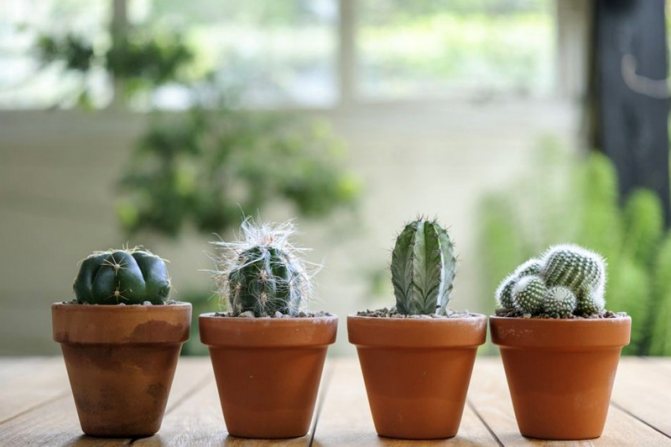

Often, the owners of all kinds of cacti begin to transplant when the roots come out of the drainage holes.
At the same time, the typical growth continues. This means that a pet with a good root system can calmly begin to build up the stem part, thorns, the formation of flowers and fruits. In a larger pot, the cactus will have to develop a set of roots again in order to master the entire substrate. In the meantime, flowering will be delayed. Therefore, there is no need to rush with this procedure.It is not recommended to replant the cactus during the flowering phase.
The signal for transplanting is both the filling of the pot with roots and the wrinkled appearance of the plant, growth retardation, loss of elasticity and characteristic color by the epidermis. Thorny (and not so) plants require updates of capacity and substrate after purchase.
Cacti - description
Cacti are succulents, that is, plants that store water in the stem. Instead of leaves, they have thorns that can be hard or soft, straight or with a curved end. The thorns grow in bunches. Some species (for example, pereskia) also have leaves.
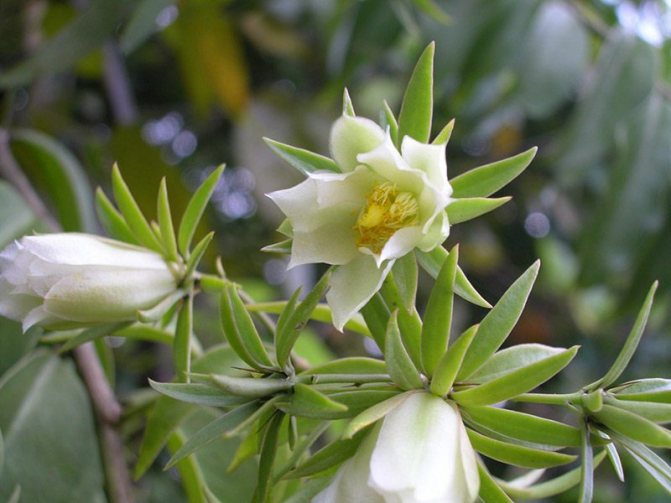

Peresky cactus
The most dangerous spines are bent, they can easily dig into the skin and pull them out is not so easy. Therefore, be sure to wear protective gloves when handling cacti.
- The Cactus family contains about 300 genera and 2500 species.
- The homeland of cacti is America, some species grow in Madagascar and Sri Lanka.
- Preferred climate: semi-desert, dry steppes and deciduous forests.
The surface of cacti is covered with a wax-like skin, which is almost impervious to water and gases. The pubescence on some types of cacti is a kind of "sponge" for absorbing water. The spines of cacti perform the same role - to collect moisture from the air.
Most cacti have spherical or columnar stems. In prickly pears, the stems are flat, consisting of segments that can be ovoid or cylindrical in shape.
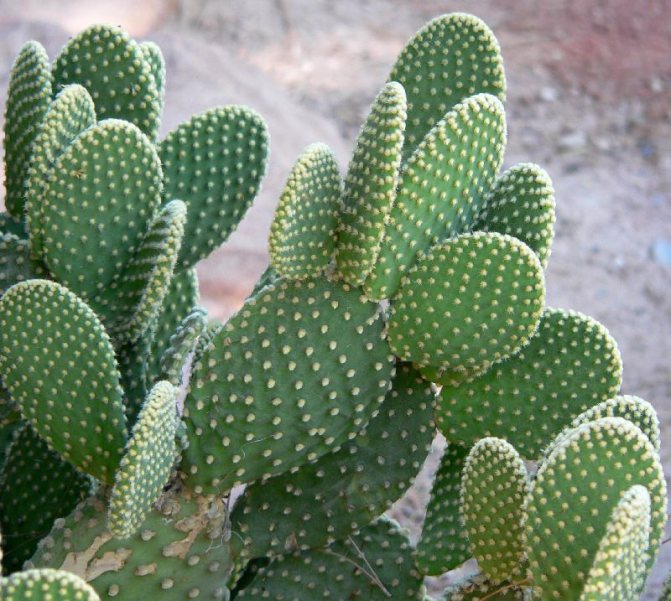

Prickly pear cactus
Flowers in cacti appear in their areoles - axillary buds. Areoles also produce hairs and spines. Some cacti can have about 100 thorns on one areola!
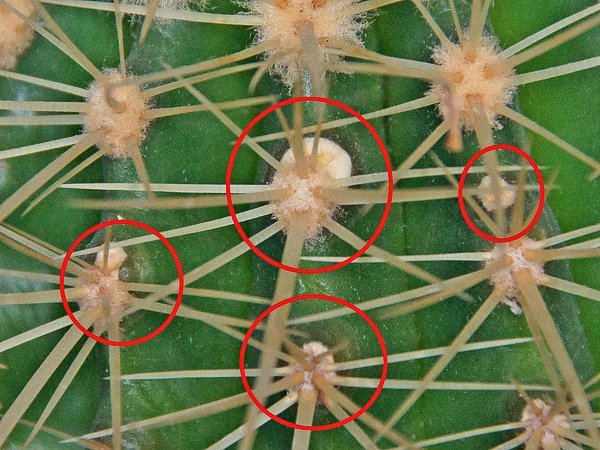

Areoles from which spines, hairs and flowers grow
Cacti bloom for a short time. Flowers can be self-pollinated or require cross-pollination. After pollination, in place of the flowers, fruits are formed, in most cases edible.


The bloom of cacti is very bright, but short-lived.
The cultivation of prickly pears occurs for the industrial production of fruits that have various medicinal properties.
- To grow a cactus, you need: a minimum of water, a lot of sunshine and a certain temperature during the growth period and during the dormant period (there are features depending on the species).
- Cactus pots need to be selected shallow, with good drainage.
- For planting, use special mixtures for cacti: loose rocky (sandy) soil with a low organic content.
- Watering from spring to winter is needed as the soil dries out.
- In winter, most cacti are kept at low humidity, without watering and at a temperature of 8-15 ° C.
Selection of pot and soil mixture
The cactus pot should have drainage holes and be 3 cm wider than the container in which the plant arrived from the store. In certain cases, you should not take a larger container. It retains a greater amount of moisture, and rot-prone varieties (ariocarpus, aztekium, astrophytum, obregonia and some others) may die as a result.
You should familiarize yourself with the features of the cultivated cactus. For example, if under natural conditions it grows in conditions of limited space for the roots, then in this case it needs a compact pot. Instances with a developed rhizome need deep pots, while those with a fibrous root system need wide ones.
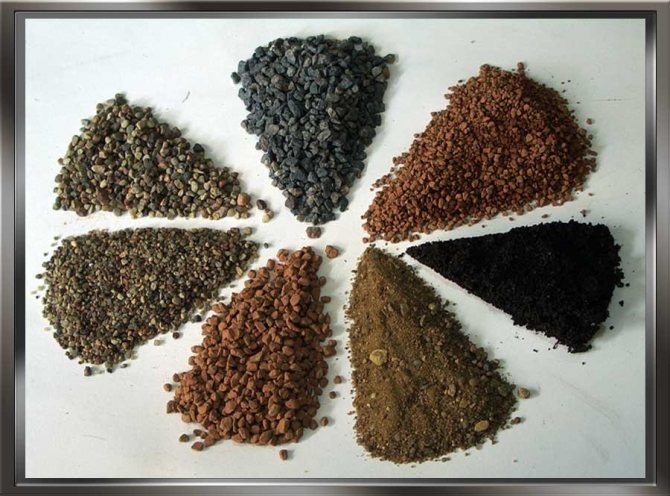

Soil for cacti
Pottery works well, and unglazed. The porosity of the clay allows excess moisture to evaporate through the walls of the container, while the roots are saturated with oxygen. The weight of the material gives stability to the product with a large cactus.
Plastic pots are more suitable for smaller cacti. It should be borne in mind that such dishes retain moisture for a longer time, a fungal infection may develop. Therefore, waterlogging should be avoided.Also, under the influence of solar irradiation, plastic (especially low-quality) becomes brittle and brittle. But on the other hand, less limescale accumulates in it.
The soil of the purchased plant must be replaced. The composition of the soil mixture depends on various factors (type of cactus, its age, etc.). It is important that it is loose, water and breathable. The acidity level is 4.5-6 pH.
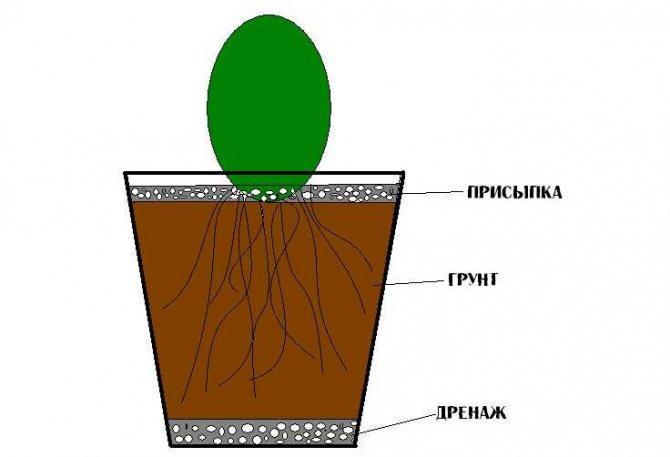

Landing rules
It is advisable to purchase a special soil for cactus or universal soil (but mix it in equal proportion with coarse sand). At home, you can independently prepare a soil mixture (the components are shown in the table).
| Substrate component | Properties |
| Leaf land | Loose and light, absorbs moisture well, contains many nutrients |
| Clay-soddy soil | Good moisture and nutrient retention |
| Old greenhouse soil | Alternative for leafy and clayey-soddy soil |
| Well rotted manure | Used in very small quantities for giant cacti when it is necessary to enrich the soil with nutrients |
| Coarse river sand | An indispensable component of any substrate for this category of plants, it provides friability |
| Zeolite granules | Contained in litters for cat litter, increase the porosity and friability of the substrate, promote moisture absorption and quick drying of the soil |
| Hardwood charcoal | Disinfects the root system, inhibits the growth of putrefactive bacteria, is good drainage (absorbs excess moisture and a proportion of mineral salts) |
| Brick chips | Helps to retain moisture by increasing the porosity and looseness of the soil mix |
| Lime | Reduces acidity levels |
| Peat | Increases acidity |
What is needed for a transplant
The procedure for transplanting a cactus is carried out with the utmost care and care. Cacti tend to be sensitive to the transplanting process. Therefore, a violation of the technique for the process of plant transplantation can lead to its death. It is noted that in the event of damage of any nature: a scratch, fracture, and so on, in most cases it is detrimental to the cactus. You should know that in case of damage to the root system, the plant dies after contact with moisture. This reaction occurs because, after watering, the root of the plant begins the process of decay, which leads to its death.
The process of transplanting cacti at home is recommended under the supervision of an experienced cactus grower. Since without basic knowledge and experience, you can incorrectly transplant and thereby ruin the plant. Any potting soil can be used for transplanting.
Transplanting a cactus at home occurs in several main stages:
- Special containers are being prepared for transplanting;
- The soil is being prepared for transplanting;
- The process of transplanting a cactus is in progress;
- Cactus care after transplanting.
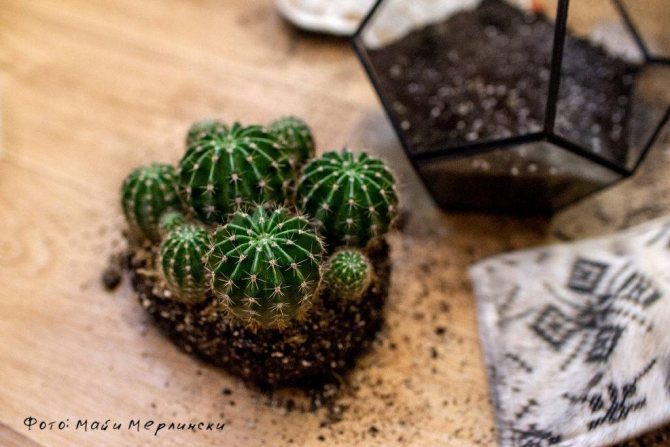

Preparing the container and soil for transplanting
Many novice cactus growers skip the process of preparing a container and soil for transplanting a cactus, which is a big mistake. In the process of such an important stage as a transplant, you need to be as careful and responsible as possible.
First you need to prepare special containers. To do this, the selected container should be thoroughly washed, dried and be sure to disinfect. As for the soil, it is required to prepare the soil mixture in advance. It is noted that the mixture must be moisturized.
Before the planting procedure, you need to stock up on the necessary components that will be required in the process of transplanting a cactus.
Required components:
- Crushed brick or expanded clay;
- Washed and dried river sand;
- Marble chips;
- Finely crushed crushed stone;
- Putrid and leafy ground.
All of the above components are required in small quantities.A small pinch of each ingredient is enough to create the desired blend.
It is worth noting that before transplanting a cactus, you need to make sure of the resulting soil. For a cactus, soil is required that is loose and easily permeable to water and air. Another clarification concerns the sand used for the mixture before transplanting. The sand should be exclusively river sand. It must be thoroughly washed and sieved to remove dust. If the sand is not riverine and sifted, then the cactus can fall not into loose soil, but into the cement soil, which will cause the death of the plant.
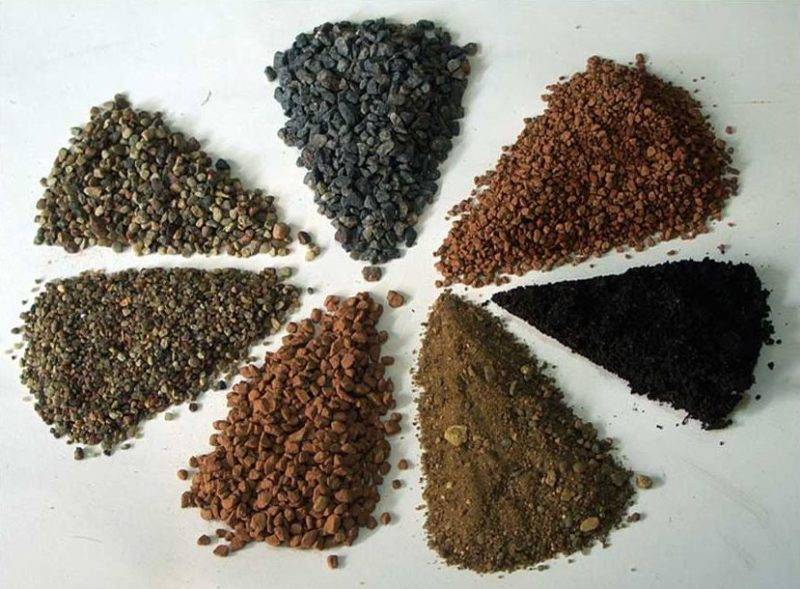

Drainage in a pot
Drainage for cactus plants is required. This device will be especially important if there is uncertainty in the choice of a pot. Drainage will significantly improve the vital activity of the plant, since, thanks to it, the cactus can get rid of excess moisture. However, even drainage devices cannot always guarantee the removal of excess moisture from the cactus, since water accumulates in the sump, from where it is not always possible to drain it on time. It is recommended to use drains of at least 1/6 of the pot volume and 1/3 of the maximum.
It is noted that the following can be used as a drainage structure:
- Expanded clay;
- Wine stopper;
- Small pieces of broken red brick;
- Crushed stone, extremely fine;
- Small pieces of styrofoam;
It is easiest to use a wine cork as a drain, as it is easiest to cut into equal parts of 5.5 millimeters each part. It should be noted that during the transplantation, the old drainage needs to be changed, since it has the property of accumulating salts.
It is recommended, before planting, to water the cactus well, so that the drainage goes away from the roots of the plant. Also, experienced cactus growers recommend adding egg shells to the drainage before planting.
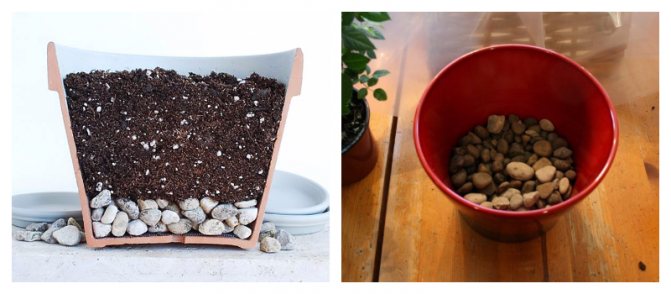

Which pot to choose for a cactus
For many cactus lovers, it becomes a big question, which pot you need to choose for planting this succulent? How to transplant a cactus into another pot? Choosing the right pot size for a cactus plays an important role in the process of its germination, so this issue should be approached responsibly. To choose a pot, you need to take into account the size and type of cactus. So for cacti of small sizes, pots with an approximate size of 6-7 centimeters are required.
It is worth noting that the pot plays an important role for the germination of the root system of the plant, since this succulent grows rather slowly. A cactus can germinate 10-15 centimeters in height in 10-20 years. Therefore, great attention is paid to the roots when planting, transplanting and during the life of the succulent. It is also noted that the shape of the pot should not be deep. A flat pot is best. This choice is due to the fact that the roots of cacti do not grow deep into the soil, but closer to the plant itself and along.
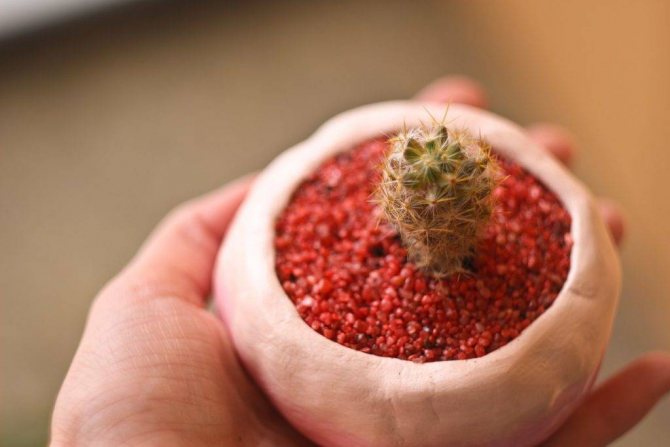

The florarium will also be an excellent solution for choosing a container for transplanting. In such a house, the plant is protected from drafts.
How to properly transplant a cactus into another pot at home
All operations with the plant must be done carefully so as not to prick.
Cactus preparation
The soil should dry well before transplanting. Watering should be stopped 3 days before the procedure for removing from the flower container.
Preparing for transplanting, you should remove the top layer of soil, turn the pot over, holding the hand protected from the cactus needles. Then, tapping the bottom of the pot on the table, knock out the earthen lump with the contents. It is not necessary to pull everything out by force, otherwise the delicate roots, which usually cling to the walls, will be damaged.
Root cleaning
It is necessary to get rid of the old soil, especially if it is store-bought. This is often done by gently shaking the plant. If the soil mixture is very dense, then place it in warm water, rinse carefully and dry it for 10 hours.So that there is no cactus tracking - hang it up.
Then it is necessary to inspect the transplanted specimen (especially its root collar), cut off all damaged, dried and rotten roots with a clean tool, and treat the cuts with sulfur powder and dry.
Features of transplantation of different types
Transplanting cacti should be carried out taking into account the characteristics of the genus and type of cacti. Each member of the family needs a special substrate with a different structure. Tall mountain cereus will need additives containing crushed marble or granite. Mammillaria grow well in soil with the addition of leafy soil, and desert prickly pears prefer an abundance of coarse-grained river sand.
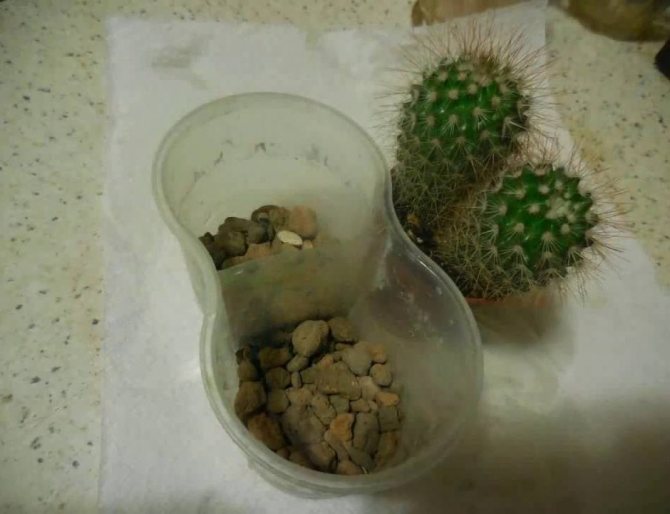

Mammillaria transplant
For cacti that do not require a large amount of moisture, it is advisable to mix brick chips into the substrate. Cacti with dense white pubescence thrive in the ground with the addition of powdered eggshells and a small amount of lime. For plants with a turnip-like root system, a component such as clay is suitable.
After the roots of the plant have been processed, you can proceed to the transplant itself. Place a drainage layer (about 2 cm) on the bottom of the new pot, pour the prepared soil mixture with a small ball and place a cactus in the middle of the container. Cover the roots with soil, lightly tamp. The plant must be watered abundantly.
What to do in order not to inject
Manipulating cacti requires special care, as there is always the possibility of an injection. A thorn can remain under the skin like a splinter. Therefore, you need to secure your hands.
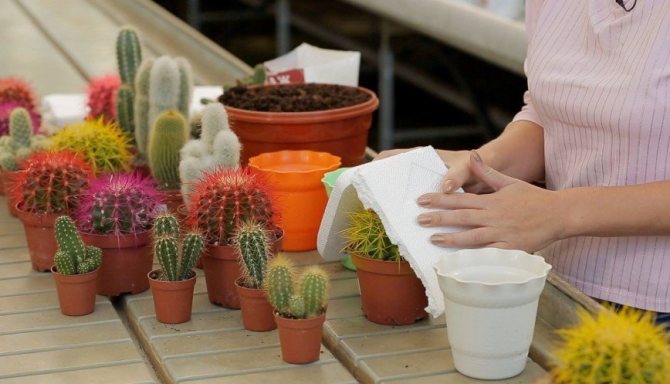

It is recommended to grasp the plant with a piece of dense fabric folded in several layers, with coarse leather or rubberized gloves.
You can use special tongs.
How cacti breed
To propagate cactus plants, you can use one of the following methods:
- children;
- seeds;
- cuttings.
Almost all types of succulents reproduce both by children and by seeds. It is not always possible to get seeds in room conditions, therefore reproduction more often occurs by children and cuttings. Sometimes, for the purpose of healing, rooting of the entire upper part of the stem is carried out.
Euphorbia is propagated by lateral and apical shoots.
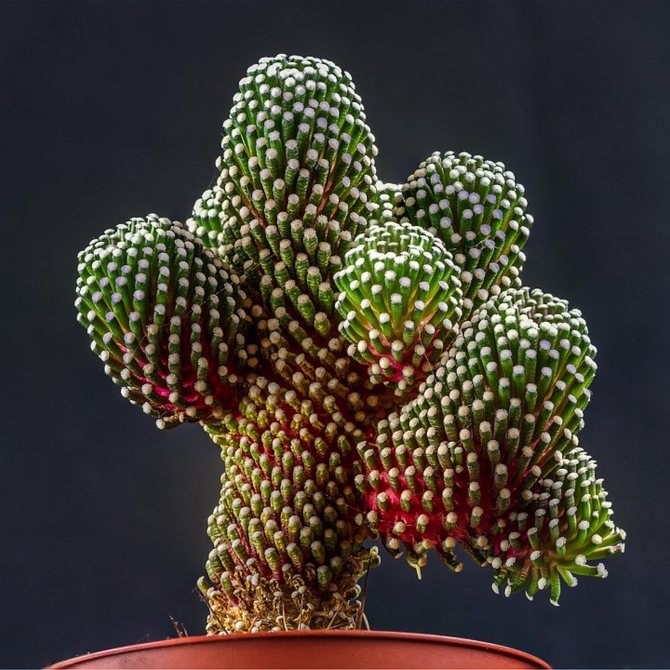

Rebuzia and Mammillaria are ready to share their babies
Reproduction by children
Babies are small spiny processes on the main stem. Desert succulents such as rebutia and mammillaria have a lot of them.
The most viable grows closer to the crown. Sometimes they fall down on their own, sometimes they need to be removed with tweezers. Those that have fallen off usually already have small threadlike roots, which help them quickly take root in a new place. So that ugly bald spots do not form on the mother plant, it is better to carefully remove the children with tweezers when they are still very small.
Seed propagation
This method takes more time than growing a new specimen from a cuttings or a baby, but this approach allows you to preserve the biological qualities of a particular subspecies or variety to a greater extent.
When the flowers wither, the dried seed pods fall off and the seeds are taken out of them. It is advisable to store them in the refrigerator before planting - stratification will ensure high germination in the future.
How to propagate a cactus by cuttings
In specimens of an elongated shape and in milkweed, the upper part of the stem (10-15 centimeters) is cut off, the cut is thoroughly washed to remove the juice - when it dries, it forms a film that prevents the growth of roots, and dried in the shade in the air. After a couple of days, the stalk is ready for planting.
On a note! Tropical cacti also reproduce both by seed and vegetatively. For the Decembrist (Schlumberger), the whip-like aporocactus and other natives of the tropics, the best time to plant with a cuttings is from March to June.
How to root a forest cactus
Several upper segments are unscrewed from the mother plant in a circular motion, dried in the shade during the day and planted in a small wide bowl filled with a third of the substrate. If there is a greenhouse, they put it there; if it is not there, the plant is covered with a glass jar and periodically ventilated. From time to time, the cutting needs to be sprayed so that high humidity remains under the jar.
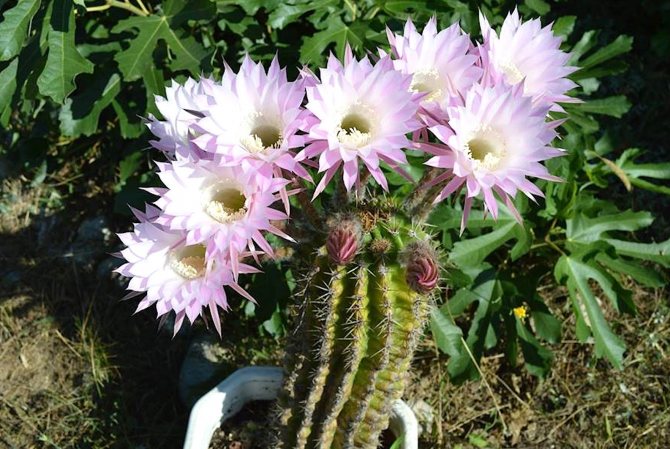

Blooming echinopsis
Currently, there are more than 2000 species and varieties of decorative cacti. Their external variety is amazing. Most cacti are long-lived, but they can bloom only with special care. For example, echinopsis, with proper care, even in indoor conditions, can live for more than half a century and all this will delight the eye with a kind of beauty for a long time.
Further care of the transplanted cactus
After the transplant procedure, the roots of the cactus must certainly dry out and harden, therefore, it is necessary to wait a little with watering. Within one week, relatively moisture-loving members of the family (such as Cereus, Hilocereus, Trichocereus, etc.) should not be watered. For cacti that are more sensitive to moisture, watering should be postponed for 2-3 weeks. For the same period, wet procedures should be abandoned if the plant showed signs of illness and lost a significant number of roots during transplantation.
To prevent the plant from dehydration, it can be covered with plastic wrap for a while. This will increase the humidity.
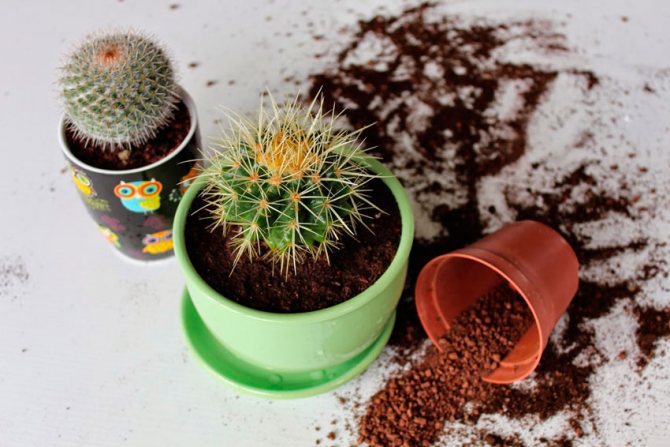

In winter, it is better not to water the flowers, but place them in a warm place for 5 days. Then you need to provide a cool rest.
When resuming watering, it is important not to direct the stream to the root collar, there should not be a lot of water. It is recommended to heat the water up to 50 ° C. Transplanted plants should not be immediately exposed to direct sunlight. For several days in a partially shaded area, they will better tolerate the stress associated with a change in soil. Large specimens will need support (until the root system is well established in the substrate).
If, during transplantation, signs of any diseases and pests were found and eliminated on the roots, then this specimen should be temporarily isolated from others.
Can you trim it?
- If the plant has deformed shoots... Sometimes it happens that the shoots are bent, become irregular, knotty, short - because of this, the flower can shed its leaves.
- If you don't want the flower to grow to the ceiling, it is necessary to cut off the upper shoots. After that, you should rinse the cut site, but this must be done very carefully, since the juice from the plant can cause irritation, burns, inflammation of the mucous membrane of the eyes and nose.
- In order for the flower to become more magnificent, kept the desired height and grew actively, it is necessary to cut it off. Also, the procedure is carried out for the sake of plant rejuvenation.
- If the plant does not branch, then you can pinch the very top of the head, then sprinkle the cut with crushed coal. After about a month, the flower should show lateral buds.
Common growing questions
Competent transplantation of cacti will be the key to their health and beauty. There are a lot of representatives of the family, they are all different and require appropriate approaches. But even in indoor conditions, these exotic plants can be transplanted without problems (including without injections).
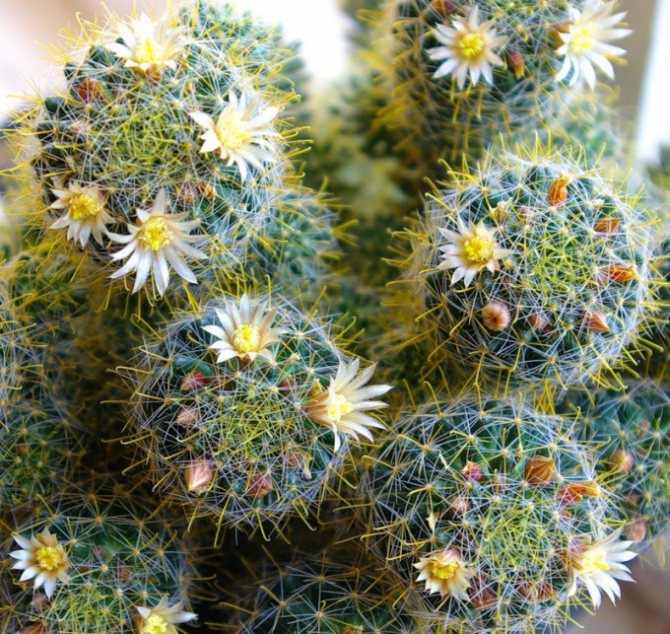

- How to prune a cactus
- How to cut
- How to make cacti bloom
- - a sharp knife or blade;
- - plate;
- - pot for transplant;
- - drainage;
- - soil;
- - sand.
- 5 tips for pruning a cactus
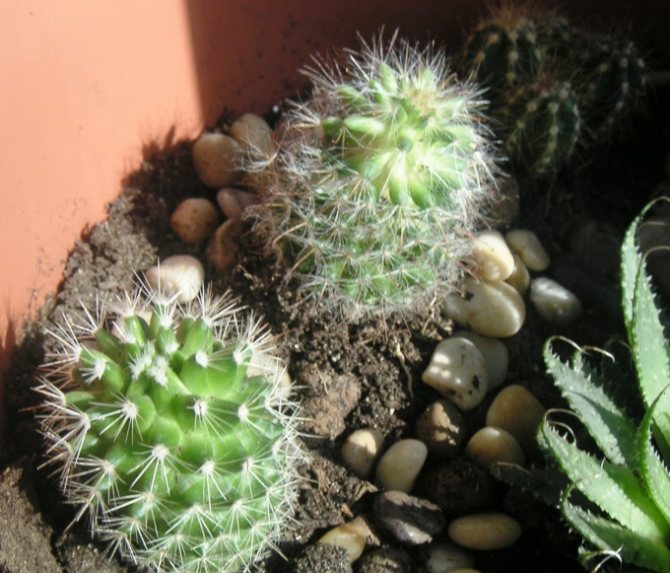

- Insect control chemicals, fungicides, fresh soil, acidified water for irrigation.
How is it correct?
For cutting, you can use a sharp knife or a special garden pruner. It is necessary to prepare sterile gauze wipes, charcoal and activated carbon. And you should also take rubber gloves for circumcision so that the poisonous juice does not get on your hands.
- Rinse the knife or garden pruner well under water, wipe with alcohol (this is done in order not to infect during circumcision).
- To be sure to stop the further growth of the stems, a sharp object must be heated.
- Put on your gloves and use gentle strokes to trim the tops and side branches.
- After cutting, a specific juice appears, it is carefully wiped off with a sterile napkin, the cut points must be sprinkled with charcoal.
- Cuttings cut from the upper shoots can be washed under warm water (so that the juice does not interfere with the growth of roots), then air-dried for a couple of days and sprinkled with activated charcoal in order to prevent rotting. Then root it into the cactus substrate.
- After all procedures, be sure to thoroughly wash your hands with soap and water.
Improper care
The first and most common reason for the death of cacti is the wrong regime and inept or careless care. The low temperature on the windowsill, the harmfulness of a warm wintering, the wrong soil - many have heard about this. But the water regime, which can confuse a novice grower, is a completely different story.
It is known that the cactus is a dry-loving plant. Therefore, many, fearing to ruin it, do not water the plant even during the period of strong growth on hot summer days. As a rule, such cacti lose roots and are not able to endure wintering.
Transfer time
A lot of novice cactusists are interested in the question of when it is better and how to plant a cactus so that it quickly begins and grows. A transplant can be performed at any time of the year; there are probably no special recommendations here. The only thing that needs to be taken into account when the shoot is transplanted, then if this is done in winter, then caring for the plant will be somewhat different from caring for a flower that was planted in the summer.
When transplanting is carried out in winter, then you do not need to water the flower until springtime. Of course, many will immediately think that if you do not water it, the plant will dry out very quickly, but this is not the case, until spring comes, nothing will happen to it. But if you water it immediately after transplanting, then your flower will most likely rot very quickly and die.
Winter is the best time to transplant, because buds are not laid at this time and the plant does not bloom. But in the spring, the cactus begins to grow rapidly, buds may even appear on it, in this case it will very badly tolerate a transplant.
The appearance of pests
The most common enemies of cacti are the worm and red tick. However, the fight against them is not too difficult, and the prevention of the appearance of pests, even more so. So, for the prevention of a tick, 4 sprays with ether sulfonate should be carried out annually. Insecticide requires only 1-1.5 g per 1 liter of water. This agent kills both the larvae and the eggs of the mites.
Unlike a tick, it is much easier to find a worm, because it is much larger. The eggs of the worm outwardly resemble scraps of cotton wool, so it is difficult not to see them. You can remove the pest with fine tweezers or a damp brush. After that, the leaves of the plant should be washed, and the affected areas should be wiped with a cloth moistened with alcohol or a piece of gauze. However, so that alcohol does not burn the stem, after smearing the plant, you need to remove the cactus for 2 days in a dark place, away from sunlight.
Drainage
For succulents, drainage plays a huge role, especially if the flower is planted in a container with small holes or when you decide to plant 2-3 cactus in one pot. The drainage layer is a maximum of 1/5 of the volume of the dishes, at least 1/2. You can make drainage from different materials: broken brick, gravel, expanded clay, wine cork. If you use a wine cork as drainage, then it will need to be cut into small pieces, their size should be about 5 mm.During transplantation, the old drainage will need to be thrown away and then filled with a new one.
If you are interested in the question of how to plant a cactus and make good drainage for it, then add eggshells there, after breaking it apart.
Diseases
The most famous cactus disease is late blight, which can quickly kill this plant. The root collar is most susceptible to decay, and therefore you should periodically carefully examine it for any damage.
In addition, illnesses can occur in an unventilated or damp room. Most often, rot affects "beefy" and loose cacti with a watery stem and thin skin. If rot appears on the plant, it must be cut off immediately with a knife. Then you need to sprinkle this place with sulfur.
The most dangerous diseases of cacti are those due to which depressed dark spots form on the plant stem. In most cases, these spots are covered with a velvety coating. A cactus disease such as diplodiosis also begins with the appearance of spots, but there is no plaque.
It is quite difficult to fight such diseases. It is recommended that you simply get rid of the infected cacti and disinfect them.
How to plant a cactus in a florarium step by step instructions with a photo
The florarium is very popular with many decorators and cactus growers. This fit looks beautiful and decorates the interior. How to plant a cactus in a florarium without harming it?
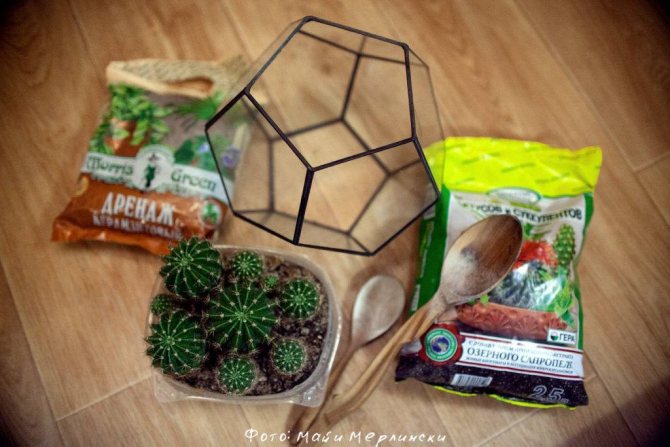

To begin with, it is worth noting that the florarium is usually glass transparent containers, such as wide bottles or transparent vases. The process of planting in a florarium is a little more difficult than planting a cactus in a pot.
The main steps for transplanting a cactus into a florarium:
- Fill the bottom of the vase with drainage 2-3 cm. And fill the prepared cactus soil on top.
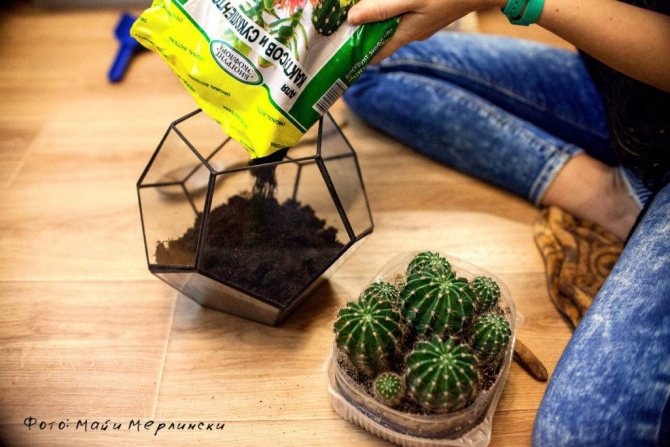

- Then you need to carefully pull the cactus out of the pot using thick mittens, potholders or sponges.
- Clean the roots of the plant from the soil;
- Carefully examine the roots and root collar of the plant for the identification of pests;
- Removal of dried and rotten roots;
- Root damage treatment;
- If necessary, carry out water procedures. (It is noted that after carrying out water procedures, the cactus should be left to dry. Drying of the roots should last about two days.)
- If the roots are in good condition, then only the longest roots can be trimmed.
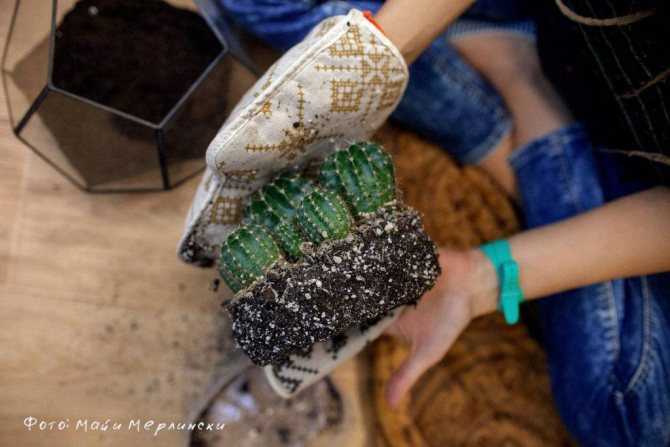

- Make a small hole in the ground and carefully move the cactus into the florarium, if you have a group of cacuts, carefully separate them, but try not to damage the roots.
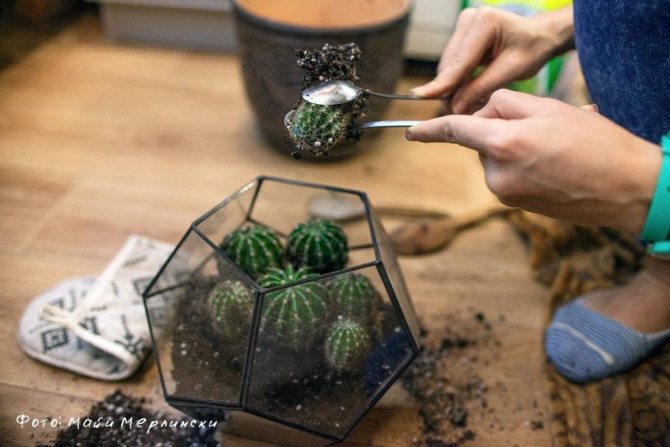

- It is required to carefully monitor the root collar of the cactus, which should be slightly lower than the substrate, when planting.
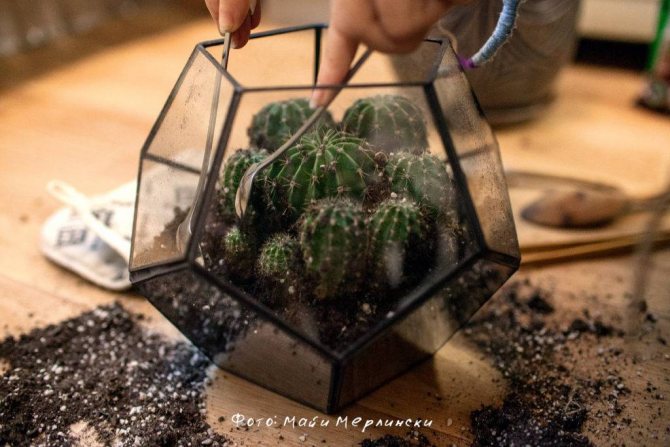

It is worth noting that a container for a cactus should be selected for the size of the plant. You can also fill the florarium with natural fillers, for example, sand. The most difficult is the very process of planting a cactus in the florarium.
After planting the plant, you will need to fill up the top drainage layer. The upper drainage will serve as a support for the correct formation of the cactus in the florarium.
How to protect cacti from rotting
Cacti are drought-resistant plants. Therefore, with improper care, which is characterized by excessive moisture, they easily rot and can die.
It is best to make a single composition from cacti and take care of them in a complex. Plants in the composition should have the most similar requirements for the composition of the soil, the temperature regime in winter and summer, the level of humidity and the amount of water consumed. Joint placement will allow not only to control the soil moisture level individually for each plant, but also protect them in case one of the plants gets sick.
Next to the cacti, to make the whole composition more decorative, you can lay out several beautiful pebbles of various shapes, sizes and colors.And a large stone placed in the center of the composition will become not only an interesting decorative solution, but also a great convenience when watering - water can be poured directly onto it, which will keep the soil from erosion and ensure an even distribution of moisture.
Plant care after transplant
- For large cacti, immediately after the transplanting process, a support that should stand for several weeks. Such measures are required in order for the root system to take root sufficiently in the new soil. After transplanting, it is also not recommended to water for two weeks. It is noted that during this period, without watering, the plant may become dehydrated. To prevent dehydration of the succulent, the plant is covered with polyethylene, which creates a high level of moisture.
- The optimum temperature after transplanting is 20-25˚. Further, a moderate watering regime should be observed, as the soil completely dries up, after which it is better to leave the plant in dry ground for 2-4 days, and only then water it again.
- After three weeks, fertilization can be applied. Take the ready-made cactus fertilizer mixture and dilute with water according to the instructions. Further, you can feed the plant no more than 1 time per month.
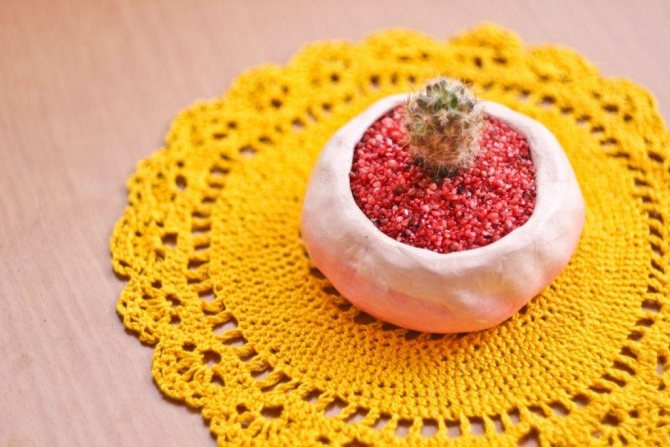

kaktus-
Joint cultivation of cacti
Expanded clay is poured into a large flat container and pots with cacti are placed on it. When the composition looks natural and most attractive, the cactus pots are slightly pressed into the expanded clay layer, and all the free space between them is filled with succulent soil, which can be purchased at any flower shop or made up of equal parts of turf and coarse river sand. The soil is compacted around the pots, trying not to leave voids. The height of the soil layer should be equal to the height of the pots.
After planting, cacti are not watered for 7-9 days, placing them in a well-lit place, but without direct sunlight.
What cacti can be rooted?
Like most succulents, the desert cactus family in the wild spreads very actively - adult plants at 4-5 years of age form miniature shoots ("babies"), which, under the influence of the wind, fall to the ground and begin to develop independently. Some species also reproduce by seeds obtained as a result of flowering and fruit formation.
cactus4.jpg
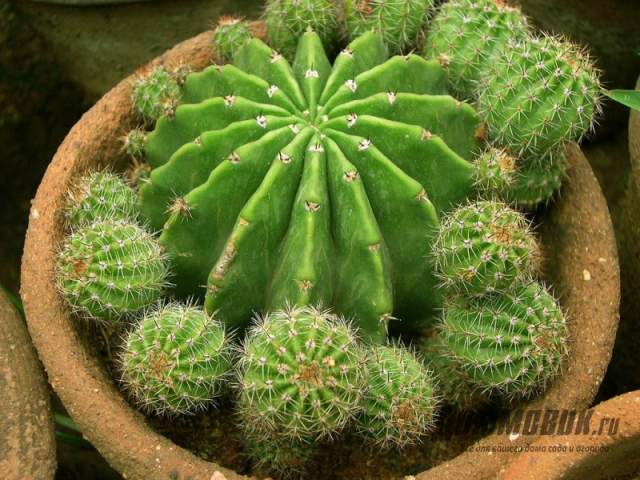

For the forest group of epiphytes, division by parts of stems is more characteristic. In particular, this method is suitable for the very popular zygocactus among flower growers (it is also called the Decembrist, Christmas cactus), ripsalidopsis (Easter cactus), epiphyllum, aporocactus, pereskia and other representatives of the tropical flora.
otdelenie-cherenka-ot-matochnogo-rasteniya-dekabrista.jpg
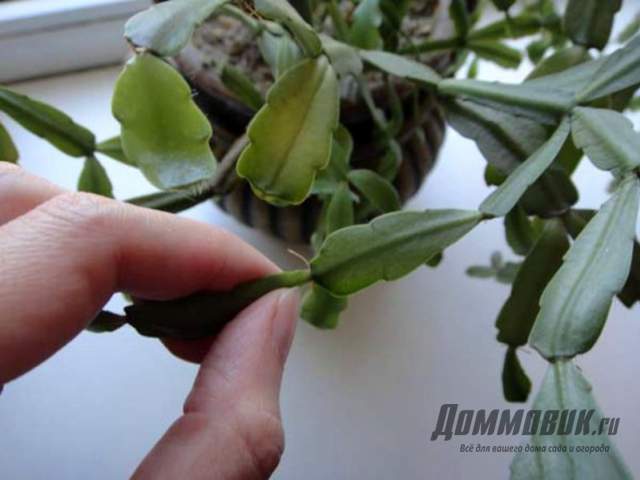

Thus, several options for "seedlings" can be rooted:
- mini-cacti in the form of shoots;
- separate fragments of the mother bush (shoots, pieces of stems);
- cuttings (cut parts of a plant).
kak-vyrastit-kaktus-2.jpg
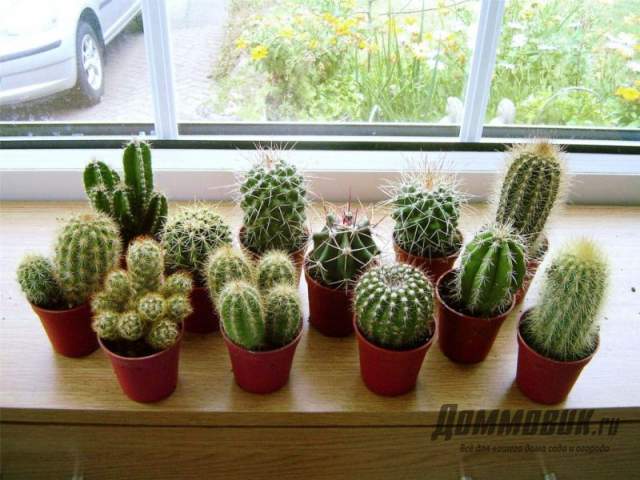

Dormant watering
Cacti, like all plants, have a dormant period when they must rest and gather strength for spring growth and flowering. Therefore, with the onset of cold weather and the beginning of the heating season, cacti need mandatory wintering with a minimum level of air humidity, a low content temperature (up to + 8 ... 10 ° C) and very rare watering.
In such conditions, cacti should be kept until spring. During this period, the laying of flower buds occurs. Flowering does not depend on watering, which should not be rushed in the spring either. During the period of awakening and the appearance of buds, cacti are recommended to be lightly sprayed with melt water. This will avoid rotting, excessive and disproportionate growth at the very beginning of the growing season, as well as preserve the beauty and harmony of your composition.
Care after
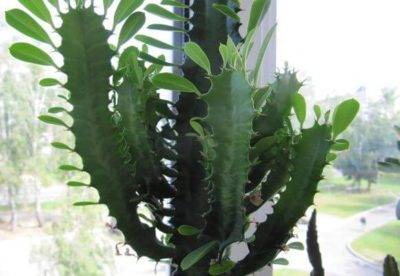

Milkweed care after pruning:
- Euphorbia tolerates drafts hard and can die, therefore it is necessary to protect it from drafts. You can keep him on the windowsill, he loves the sun's rays, but does not tolerate extreme heat, he can get burns.
- In winter, the plant can be equipped with additional lighting in the form of special ultraviolet lamps. Euphorbia will not die from lack of sunlight, but if it stands in the shade, its leaves may lose their rich green color and become dull.
- It is necessary to monitor the moderate watering of the plant, excess water can destroy the root system of the flower, therefore it is necessary to water it in accordance with the season. In the summer, it is watered once a week, in the winter it is rarely watered, this is done no more than once a month, while spraying is stopped completely, otherwise the leaves may fall off from excess moisture.
- Euphorbia is a thermophilic plant.
- The humidity should preferably be 40-50%.
- The soil should be for succulent plants, but if there is no way to buy one, then the soil for cacti is quite suitable.
- It is advisable to transplant the plant in the spring, since the euphorbia recovers as quickly as possible during this period of time.
Photo
In the photo you can see a cactus with "children":
The location of the flower in the container
If one copy is planted, then it should be placed in the middle so that future roots grow evenly, filling the earthen lump. And when the tank is intended for a mix planting, then the size of adult cacti should be taken into account. Larger plants should not shade smaller neighbors and prevent them from growing green mass. To prevent their roots from intertwining, you can use special plastic spacers.
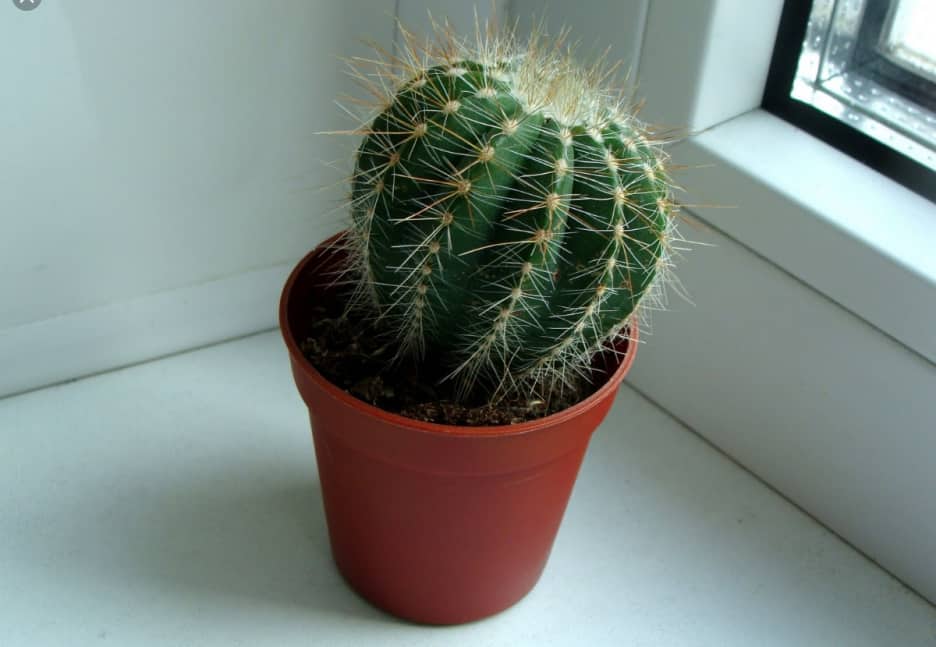

Landing
Cacti reproduce in three ways.
Children
Planting by children is the most common because of its simplicity. To do this, you must adhere to certain actions.
- Separate the baby (lateral process). Some of them may disappear over time. If this does not happen, you will have to separate it with a knife. This must be done with care so that there are no extraneous pieces left on the adult cactus or baby, which can subsequently rot.
- If there are no roots on the children, they need to be grown. First, the baby is put aside for several days so that the cut dries up. Then wet sand or water is poured into a narrow bowl, and the baby is set so that there is no direct contact with moisture. Dipping babies directly into water is risky because they can rot.
- A baby with roots can be planted in a pot. To begin with, it should not be large - only a few centimeters larger than the diameter of the baby. For planting, take a pot with a prepared soil mixture, as described above. Then a small depression is made in the center, into which the roots of the cactus sink to the border of its neck. The soil around should be slightly compacted.
- To keep the cactus smoother, and its neck is not in the ground, you need to pour some drainage stones on top, for example, expanded clay.
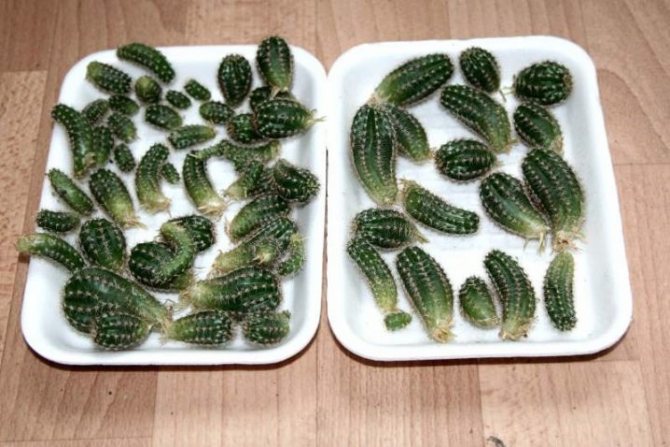

Cuttings
Planting cuttings is a bit like the previous method. For the cutting, you can take the top of the cactus. It should not be too short, because the substances accumulated in it should be enough for growth. In this way, a broken plant can be reanimated. The procedure in this case will be as follows:
- after separating the top, the cut on the cactus can be left as it is or powdered with crushed coal;
- the cut must be slightly trimmed in the form of a cone; it must air dry, which can take up to 10 days;
- then you need to do with him as with children who have no roots - fix it in an upright position above wet soil or water;
- after the appearance of the roots, we proceed to planting.
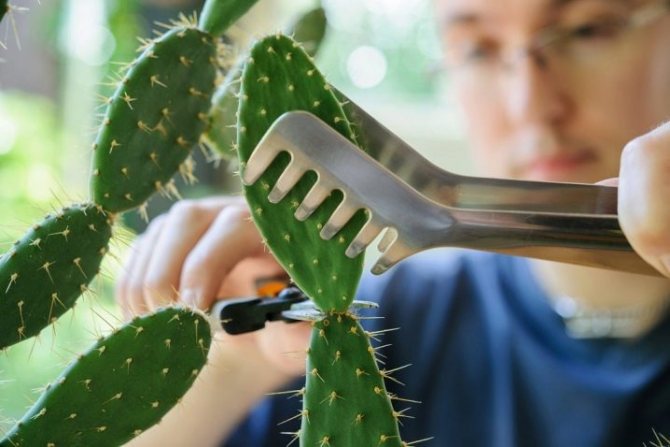

Seeds
Growing cacti from seeds is the hardest part. Even professionals have a certain percentage of losses.For amateurs, it will be very high. However, over time, you can take into account your previous experience and delve into the intricacies of this matter in more detail. To germinate seeds, follow these steps:
- process the seeds with potassium permanganate; the earth must be disinfected with steam or boiling water;
- soil is poured into a shallow but spacious container with numerous holes at the bottom, then seeds are laid on top in rows;
- so that the seeds do not shift, watering should only be from the bottom;
- the entire structure must be covered with any transparent material (film, plastic or glass).
Read also Super yielding varieties of tomatoes
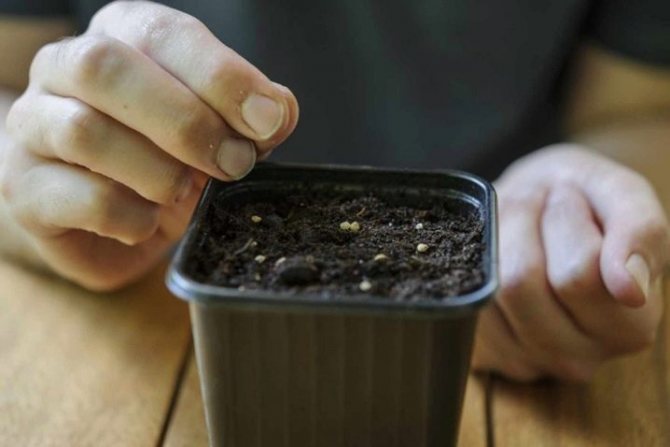

After germination, be sure to remove the remnants of the seeds. And the first stage of the pick begins. They must be carefully moved to another container with the correct soil and good drainage. It goes like this:
- any improvised tool should draw a symbolic groove in the ground;
- with a minimum deepening in them, sprouted cacti must be planted - for this it is better to use tweezers.
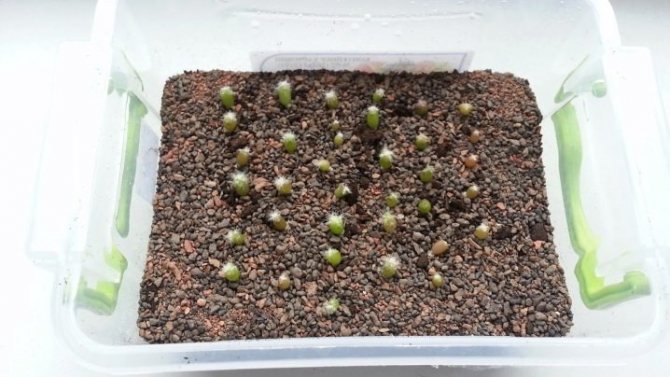

How to plant cactus babies
This is the name of the lateral shoots growing from the stem or root system, with the help of which the culture forms new independent plants. In some varieties, air roots are immediately formed, which greatly simplifies the reproduction of the succulent. The procedure is carried out after flowering, so that the plant does not lose the inflorescence, and adapts faster.
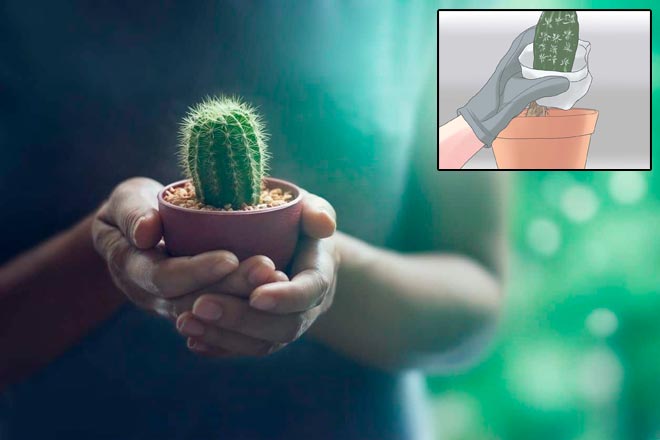

When growing a cactus from a shoot without roots, it is important to carry out the operation correctly, otherwise decay is possible:
- cut with a sharp disinfected knife, making an even cut;
- if a piece of the baby remains on the mother specimen, the death of the plant is possible, therefore the damaged area is carefully cleaned from the pieces of the appendage, you should also do with the cuttings;
- dry the cut site for several days.
In the presence of air roots, the cactus should be planted in the usual way in a slightly damp soil substrate.
We must not forget for good drainage, the requirements for the soil and capacity. Top dressing is prohibited, it is enough to periodically moisten the soil from a spray bottle.
We breed cacti, seating children
The simplest way to reproduce cacti is by shoots. True, it can only be used with those species in which children are formed. The strongest shoots are located in the upper part of the plant..
The air temperature in the room with this breeding method should be at least 18 ° C.
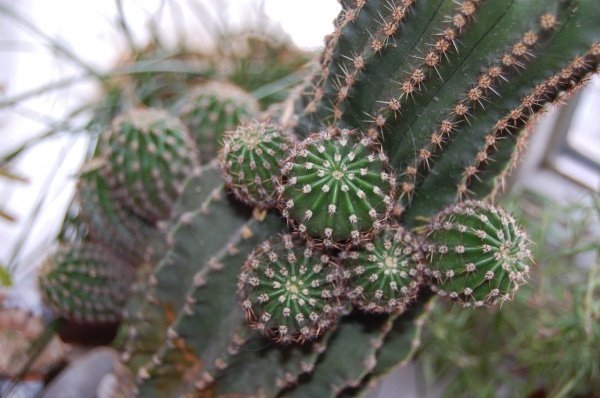

These kids are good for the separation
Progress:
- In the spring, cut the babies from the mother plant with a clean and sharp knife.
- Leave the shoots to dry for 1-2 days. During this time, small wounds that appear when separated from the mother plant are healed, this will help to avoid infection.
- Prepare a large pot of sand (in a small container, the latter quickly releases moisture). The soil should always be moderately moist. Also required are drainage holes at the bottom of the container to remove excess water.
- Shallowly (small offspring - 1/4 part, children the size of an egg - 1/6 part) plant the offshoots in wet sand. Roots should appear in 3-5 days.
- After 3-4 weeks, transplant the young cacti into permanent pots.
Some cactus species form roots while still on the parent plant. After separation, they can be immediately planted in separate containers or rooted in a pot next to an adult cactus.
Dry rooting of the offshoot in the air or in the sand
With this method of rooting, children are simply placed vertically on the weight or planted in dry sand. Thanks to the nutrients and water accumulated in the shoots themselves, after 1-2 weeks, the children will have roots. However, if the process is delayed, more than a month has passed, and there are still no roots, the shoots will need to be urgently planted in moist soil.
Will the plant take root in water?
Some growers practice this method: the shoot is lowered into water and waited for the roots to appear. But in this case, the likelihood of decay is very high. This can be avoided if you try to position the cacti above the liquid: for example, place the plants in the holes made on a sheet of cardboard that covers the container with water.
Professionals never use this method, as it is ineffective with cacti.
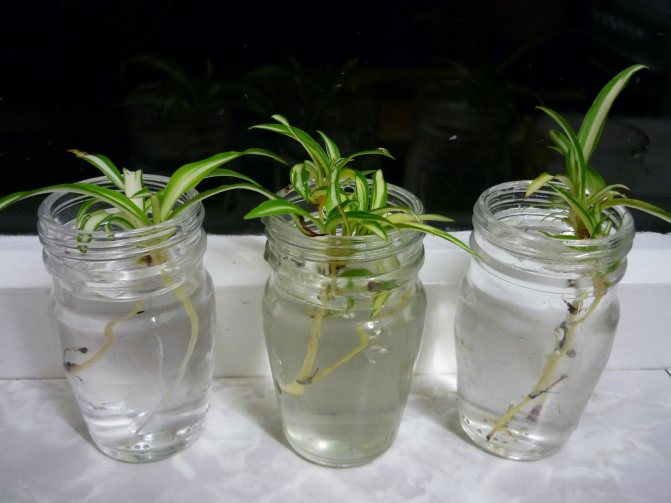

Sprouting in water is a common method, but it is not suitable for cacti.
Video: How to grow prickly pear?
Cactus pot
First of all, it is recommended to focus on the size of the root system of the flower. And since in the case of cacti, most often it is necessary to plant planting material without roots, it is more convenient to use small cups or boxes with small individual cells.
From what material the tank is made, in fact, it does not matter, you can not only take iron containers. The most commonly used tanks are plastic or ceramic. The presence of drainage holes in the pan is mandatory, the accumulated water should be removed. As a permanent residence for cacti, it is better to take shallow containers, most cactus have a superficial root system.
Grafting cacti
Grafting is one of the methods of vegetative propagation of cacti, which has a specific purpose.
Why plant cacti
- grafting is done in order to make a cactus bloom, which is difficult to bloom;
- grafting is done when the cactus can die from the fact that it has lost its roots (for example, they have rotted);
- grafting of cacti is done when it is not possible to root the stalk in another way;
- cacti are grafted when the species is very difficult to maintain, if it grows on its own roots;
- when just wondering what it looks like or to get a curious combination.
With all the advantages of grafting cacti, there is a significant drawback - grafted plants, in most cases, are not durable, since this is still not a natural operation for plants.
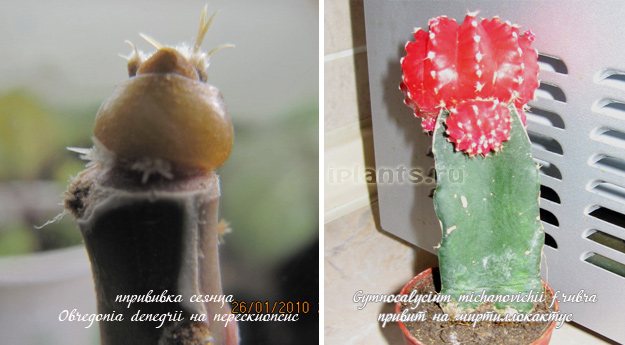

In general, grafting on rare species of cacti is better for an experienced cactusist who knows these plants for several years, since this is a complex and painstaking procedure, in which failures often occur from the slightest violation of the rules.
When vaccinating, the following conditions must be observed
Vaccinations should be carried out in the spring, or at the beginning of summer, except for those cases when the roots of the cactus have rotted in the fall, I really do not want to lose a valuable specimen. Even then, the result may not always be positive. If, nevertheless, it is necessary to vaccinate in winter, the cactus stock must be brought into a state of growth by increasing its watering, illumination and increasing the ambient temperature for this.
Rootstock - the cactus that is grafted onto must have a good healthy root system and be in a state of growth. As a stock, you can use only a healthy cactus, which was transplanted at least a month before vaccination, is not inclined to form children. The most commonly used rootstock is Eriocereus jusbertii. The reason for this is simple - this cactus is unpretentious and grows quickly.
All instruments must be sterile, for this they are wiped with alcohol. It is better to wipe both cacti, which will be used as rootstock and scion, with a brush dipped in alcohol.
The cut should be fresh, not dry in time.
The stock and the scion should be aligned so that their cambial rings on the cut coincide as best as possible, so the diameters of the cuts should be such that the diameters of the cambial rings are also the same. It is on the coincidence of the cambium rings that the success of the inoculation largely depends.
Cambium is a layer of cells of educational tissue (meristem), located in the thickness of the cactus stem and roots. It is clearly visible on the cut of the stem in the form of a ring.The cambium cells give rise to secondary conducting bundles; when the cambium rings on the rootstock and the scion coincide, if they did not have time to dry out, accretion occurs. The more the cambium rings on the rootstock and the scion match, the better, but they should match at least partially.
The cuts on the rootstock and scion should be horizontal and even, and the bandage connecting the two plants held them firmly, but did not cut into the tissue of the cacti. By the way, you can also graft seedlings, cut over the cotyledons.
Cactus grafting technique
After the cacti are cooked and treated with alcohol, the tool is disinfected, the top of the rootstock and the scion are cut off. Immediately, until the sections begin to dry out and oxidize, they must be aligned so that the conducting bundles of cambial rings coincide as much as possible. To press the scion to the stock, it is recommended to use threads or a thin elastic band.
I did this: I cut off two thick nylon strips from tights. First, I took one of them and glued one of its ends with tape or plaster to the wall of the pot. I threw the thread over the connected cacti between the thorns and pulled it from the opposite end of the pot so that the thread did not cut into the skin of the cactus, but at the same time firmly held the scion on the rootstock. Then, using the same tape, she glued the other end of the thread. In the same way, I pulled the second thread, only from the other side of the pot, so that both threads were crosswise. Instead of nylon thread, you can use a plumbing fumule.
It is important to act quickly during vaccination. If something went wrong with you, the procedure is delayed, then either make fresher sections - they should not be dry, or cover the sections with a piece of cling film to protect them from drying out.
In some cases, the rootstock, on the contrary, produces too much juice, like in Eriocerius, and interferes with the correct and tight alignment of the cambial rings. Stock up on sterile gauze pads in advance. Never wipe the sections with cotton pads or cloth.
Care
Spray the plant occasionally throughout the month., and inspect it regularly for rot.
Do you grow cacti and follow all the rules for caring for your prickly pet, but at the same time he does not feel well, looks lethargic or even fell into hibernation? The secret to the luxurious growth and flowering of a cactus is simple - it needs to be fed well and regularly. Read on the pages of our website about suitable fertilizers for this plant - what composition of vitamins is needed and how to choose the right feeding.
What can be done to prevent fungal diseases?
Cacti lack resistance to fungal diseases. This should be taken into account and when planting, be sure to disinfect dishes, soil and tools.
After the cutting is separated from the mother plant, it must definitely dry out. During this time, a callus will form on the wet surface, which resists decay well.
If, nevertheless, the plant is affected by rot (the cactus tissue in this case turns into a slimy mass), then you can try to save it. To do this, cut off the healthy part of the flower above the spread of rot and leave to dry, and then try to root.
It is also possible to prevent the development of rot by dipping the freshly cut sprout into garden sulfur before planting.
Thus, the optimal breeding method depends on the type of cactus and the preferences of its owner. In any case, it is worth remembering: although the flower is unpretentious to care for, it requires no less attention to itself than other houseplants.
Why can't you root?
Cactus is a plant that does not require special attention and care. Almost all attempts to reproduce it are crowned with success. But certain difficulties can still arise.
- Seeds do not sprout.
Most likely, the seeds were covered with a thick layer of soil. The situation cannot be resolved; this fact should be taken into account in the next attempt. Or the temperature in the room is not high enough, perhaps the florist forgot to cover the container with glass or film. The way out is to increase the temperature in the room, create a mini - greenhouse. A shoot without roots is withered.
Drainage system
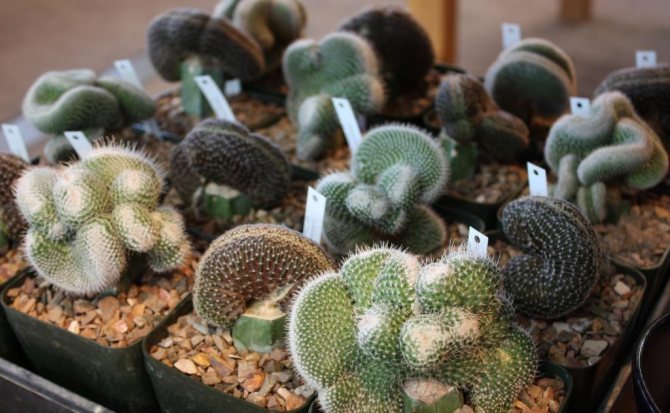

What is it for? In the absence of proper drainage, it will not work to grow a beautiful plant. It is usually a layer of materials that help drain excess water. The drainage should occupy from 1/5 to 1/2 of the container.
It may include:
- pebbles;
- expanded clay;
- small stones;
- broken brick;
- chopped wine corks;
- broken foam.
Growing from seeds
Cactus seeds are sold in specialized stores. They can be planted in late January or early February, if there is a well-heated and well-lit greenhouse, otherwise it is better to postpone the process to late April or early May.
To grow cacti from scratch, you need:
- Soak the seeds in warm water the day before sowing.
- Before the procedure, drain the water, and instead prepare a weak solution of potassium permanganate and leave the seeds in it for 10 minutes. Then remove the liquid and dry the seeds.
- Place drainage on the bottom of the pot with holes, and on top pour a layer of substrate 1–2 cm thick.
- Spread seeds on it (3-5 pcs per 1 cm2). They do not need to be pressed into the ground.
- After sowing, immerse the container in water. The liquid will penetrate through the drainage holes and the soil will be saturated with it. Then moistening the substrate as needed (it should not be allowed to dry out) must be done in the same way.
- Cover the container with glass and keep at a temperature of 25-30 ° C. You need to ventilate the ground 1-2 times a day.
- Seeds of different species sprout from days to several months (for example, phyllocactus and astrophyllums germinate in a few days, and prickly pears and epiphyllums - up to 6 weeks). When the seedlings reach the size of a pea, it is supposed to transplant them into individual containers, deepening so that the growing point is above the ground surface. Watering is carried out once every 3-4 days.
Video: Cactus cubs from seeds in the ground
Video: Germinating seeds without land
Suitable place for a plant
When studying the information about your purchase, pay attention to the environment in which it grows in nature. In our opinion, all cacti grow in the desert, so at home we try to create similar conditions. Such a climate will be unacceptable for those species that grow in the forest and are used to shade and moisture. Therefore, a window sill is suitable for someone, and a chest of drawers or a shelf for someone.
The main thing is that they are in the light, not in the shade.
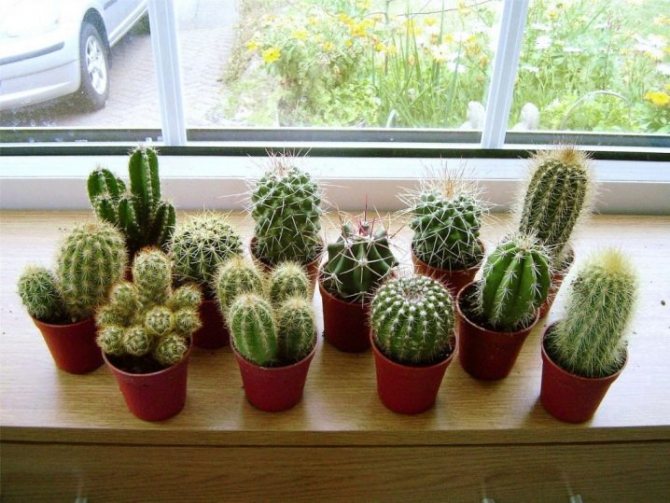

Conditions for all cacti should be slightly different during summer and winter. In the first case, you need moderate but constant air humidification, timely watering and sufficient lighting. In the second, the air temperature should be much lower, as well as the soil moisture. The main thing in both cases is to beware of overheating and sunburn. If the cactus is on the windowsill, protection is needed equally from both heating appliances and aggressive sunlight.
Read also Cornflowers in landscape design photo
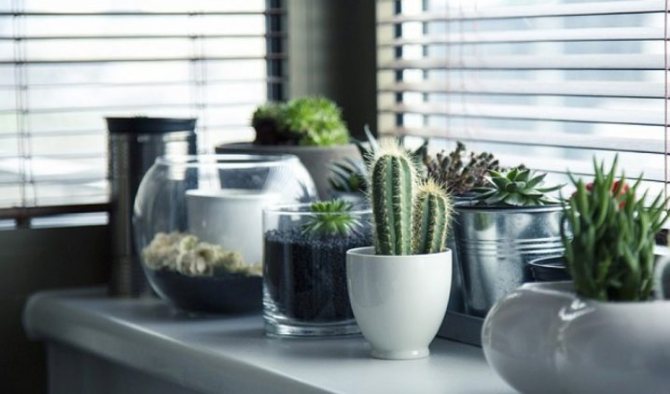

In summer, cacti can be safely placed on the glassed-in balcony. In this case, they do not need to be brought indoors at night, since in the same desert it is quite cool at night. For them, ventilation is important so that the air does not stagnate. But this process needs to be organized no drafts... It is better to get used to bright light and other air temperatures gradually.
Cacti do not like permutations - you can put marks on the pots so as not inadvertently to put them on the other side to the light.
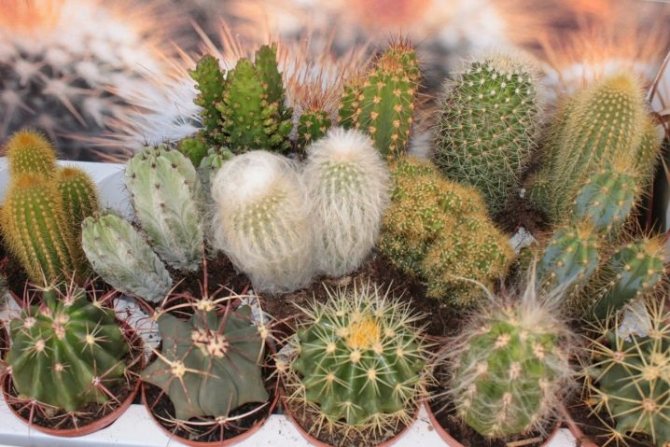

Most often, the placement of cacti is associated with various rumors and omens. For example, in feng shui, the southeastern part of the room is best suited for them. It is believed that placing on a windowsill repels negative energy from the street and protects against thieves. And placement next to electrical appliances reduces the effect of negative radiation. There is no scientific evidence for these superstitions.
Therefore, when placing a pot with a plant, first of all, you need to think about its comfort - in poor conditions, development will be slow, and frequent movements can affect the change in appearance.
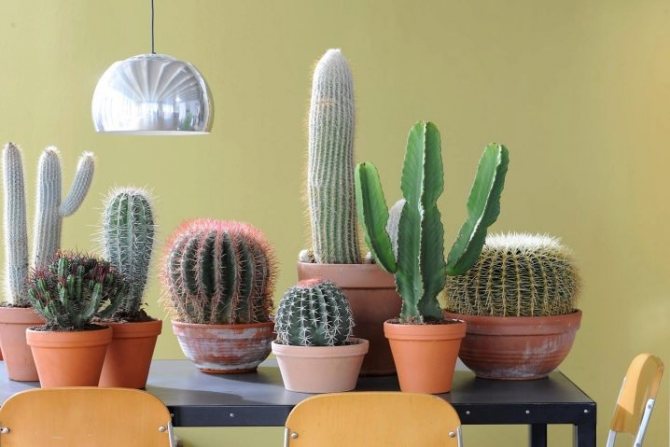

Features of seed reproduction of cacti
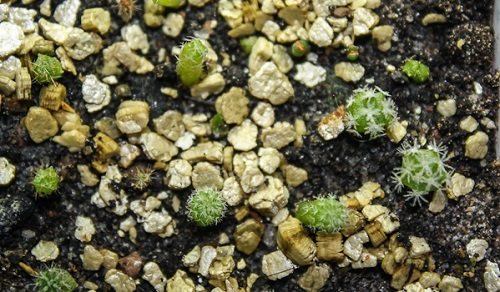

You can sow cactus seeds throughout the spring, and some of their varieties even in August (in particular, South American). To do this, pour a nutrient substrate consisting of an equivalent mixture into a shallow dish with drainage holes:
- leafy land;
- turf land;
- coarse sand.
In addition, a little charcoal (no more than 0.5 parts), previously crushed, must be added to the substrate.
Seeds must be prepared before sowing: soak overnight in warm water, and then for 10 minutes in a solution of potassium permanganate. Dry after disinfection.
Using a stick, make shallow grooves and put the seeds in them, making an indent of 1 cm between them. Instead of surface watering, the bowl should be placed in a bowl of water. When the earth absorbs moisture, cover the container with foil or glass and put it on a light windowsill, where it is warm. In the future, watering is carried out by spraying. After the emergence of seedlings, the greenhouse can be opened, and when the first thorns appear on them, the cacti can be dived into separate pots.
Not all types of cacti form seeds, so vegetative propagation is still used for most of them.
Reproduction methods
Sooner or later, many cactus begin to grow, overgrowing with children along the trunk or around. And it is important to know when it is possible to put the "kids" away, how to do it correctly, so that they do not rot or dry out and necessarily give roots.
If you act correctly, then the cultivation of cacti will turn out to be a very effective business:
- methods of vegetation are most often used;
- it is better to plan an event in the spring, at which time all flowers are active, root and grow faster;
- plant a cactus - a shoot or a baby, in a separate pot is possible only when it takes root;
- it is impossible to root cactus in a container of water, they will rather rot than take root.
Picking cacti or replanting them
After the seedlings have formed roots, it is necessary to transfer them to a deeper general container for further development. Root shortening is not required for healthy plants. It is important to plant the cactus correctly, since even a slight bend in the root can cause decay. For this reason, non-standard methods of carrying out the procedure have been invented.
Pick cacti step by step:
- Pour a drainage layer about 1 cm thick into a clean disinfected container.
- Cover the top with a small amount of soil mixture.
- Place the container at an angle of about 30 ° so that the substrate does not crumble, but the seedlings can be laid on their side.
- Cover one wall with soil, lay a row of seedlings, taking into account a further increase in size.
- Place the root collar on the soil surface, straighten the roots.
- Gently sprinkle the seedlings with soil mixture on the other side. In the same way, lay out the 2nd row and subsequent ones.
When transplanting by laying on a hill, cacti often do not occupy a vertical position, therefore, after filling the container, it is required to straighten the seedlings with tweezers. Lightly compact the soil by tapping on the edges of the container. Pour a small layer of river sand, again to achieve the subsidence of the substrate.
If the root system remains intact, it is allowed to water immediately.In case of minor damage, leave for 5-7 days, then put the container in a basin with settled water at room temperature until the soil is saturated with liquid. The surplus released later must be removed from the pallet.
There are several ways to plant a cactus at home. The absence of roots does not make the operation impossible, since the plant takes root well if the basic agrotechnical recommendations are followed. Sowing seeds is also sometimes required, since over time the culture loses its decorative effect, becomes more susceptible to the effects of adverse environmental factors.
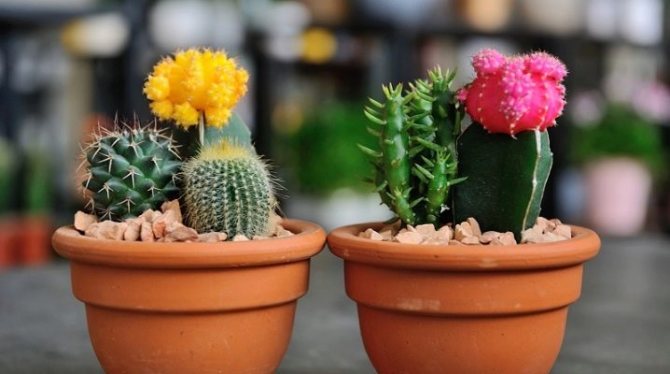

Cacti occupy a special place among indoor plants. Sympathy for them is quite understandable - this is facilitated by both an unusual appearance and the absence of difficulties in care. If you follow some recommendations, growing cacti will be a pleasure and turn into a pleasant hobby.
Cactus variety
Many cacti are very prolific and it is normal for them to grow overgrown with many children, and they do this even with comfortable maintenance and good care. For example, the popular mammillaria, especially of the proliferative or shoot-bearing species, is distinguished by its "large number" and it is even difficult to imagine such a specimen without an abundance of baby crumbs.
But, in some cactus in "ordinary" life, shoots are absent or they are very modestly and reluctantly detached. And if such succulents are suddenly covered with an abundance of children, then most likely this is due to a violation of the microclimate or other failures. As a rule, succulents that are in dense, nutritious soil rich in organic matter grow abnormally and multiply. Such soil is not suitable for cacti, as it contains a large amount of nitrogen and should be replaced with a poorer, lighter and more airy soil mixture. When the flower falls into the usual land, its growth will normalize and the children will diminish. In addition, there are the following situations:
- There are cases when a baby appears on these plants in place of buds. The cactus is preparing to bloom, but under the influence of unfavorable conditions, this process is disrupted and the bud turns into a baby.
- With poor care and maintenance, the succulent can "turn on" defense mechanisms. And the cactus, thinking that imminent death awaits him, tries to leave behind as many successors of the genus as possible.
- Most of the specimens raised from children also produce a considerable amount.
- New shoots can appear in a plant with a damaged growth point. Sometimes cactus growers use the last feature of cactus plants for further reproduction and replenishment of the collection - they cut off the top of the flower and grow a mother plant from it, a specimen that gives many children.
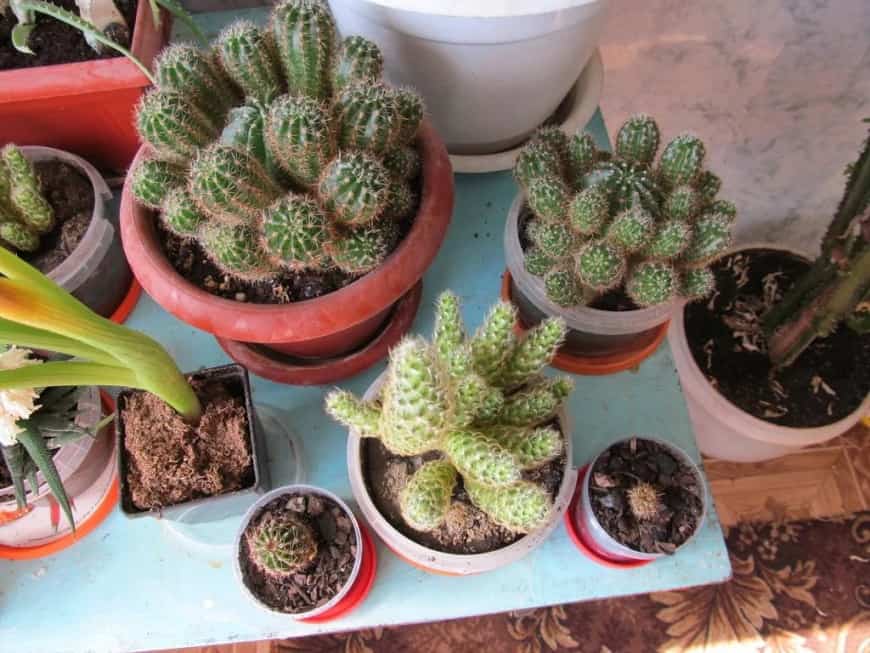

Methods for vegetative cultivation of cacti
This method is more often used by flower growers. It consists in rooting:
- Kids... This is the name of the shoots - full-fledged young plants that are formed on an adult flower of some types of cactus. They almost always have their own root system, so they root well and quickly. In most species, the children crumble themselves, but there are also such cacti where they have to be torn off.
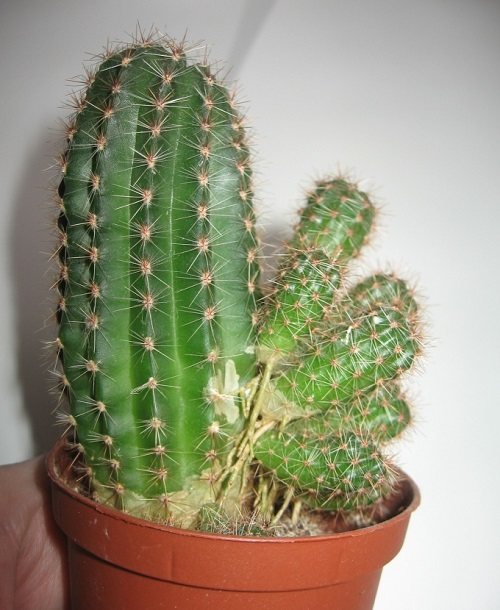

- Cherenkov. It is used for propagation of columnar cacti and plant species with long, non-segmented shoots. In the first case, you should cut off a stalk up to 15 cm long and "round off" its lower part so that the roots grow from the center. Most varieties require drying of the cuttings, but some cacti can be rooted immediately (ripsalis, epiphyllums). Leafy cacti propagate using leaf pieces.
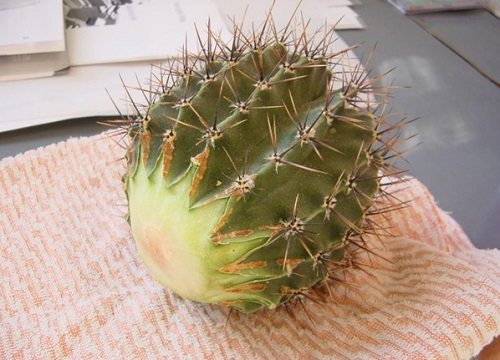

The most viable are children and cuttings taken from the upper part of the cactus, and it is better to start this method of flower reproduction before the growing season or after its end.
In addition to the listed methods, there is another very interesting method for propagating cacti - grafting two different plants. Most often it is used for those species that are difficult to grow on their own or for experimental purposes to obtain an original specimen. Also, this method is quite acceptable if you need to urgently save a flower that has lost its roots. As a rootstock, it is necessary to choose varieties with fast growth and the absence of children.
Features of rooting cacti - video
The sight of a blooming cactus causes genuine admiration even among people far from indoor floriculture. During this period, a modest-looking plant is covered with bright and spectacular flowers, giving it a special decorative effect. Very often it is the luxurious look of the cactus, decorated with unusual flowers, that inspires and motivates growers to expand their green collection. How do cacti propagate at home? What methods are used for this? What should be considered when breeding these exotic plants?
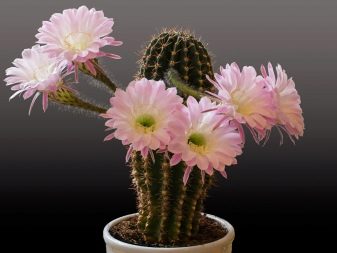

Methods and rules for vegetative breeding
Vegetative cultivation of cacti involves the use of "babies" and cuttings obtained from strong healthy plants. These methods are among the most simple, so even a novice florist can use them.
"Children"
This method of breeding cacti is allowed to be resorted to all year round. However, it is best to propagate plants by "children" in the spring-summer period. If it becomes necessary to grow a young cactus from a shoot in autumn or winter, the plant should be provided with sufficient illumination and optimal temperature and humidity conditions.
For growing "kids" use a special substrate for succulents or a soil mixture prepared from the following ingredients:
- fertile and loose garden land - 1 part;
- clean coarse sand - 1 part;
- peat - 0.5 parts.


Crushed charcoal and / or fine foam fractions are introduced into this mixture as drainage elements. The drainage should also be poured into the bottom of the container in which the shoot will be grown. Here you can use crushed expanded clay, brick chips or pebbles as drainage.
A convenient plastic container of sufficient width and depth is suitable for growing cacti. Considering that these plants have a very strongly developed root system, small and small containers will not work for them. At the bottom of the selected container, holes must be made to drain the water.
Having prepared everything you need, you should carefully examine the donor plant and carefully separate the largest and strongest shoots from it. In the majority of cacti species, "children" by the time of separation already have the rudiments of roots, so it will not be difficult to disconnect them from the donor plant.
It is only important not to damage the shoot, otherwise it will not take root, and the donor plant may get sick.
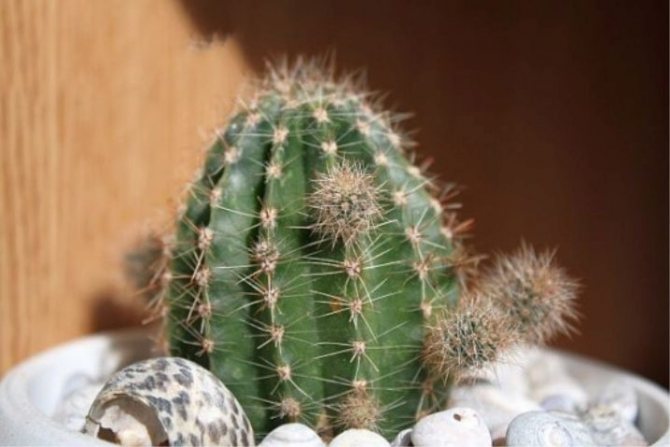

In some cases, when the “baby” has no roots and is tightly attached to the mother plant, it is cut off with a sharp blade. After this, the cut sites are treated with activated carbon powder, and the process itself is placed in a dark place for a couple of days. When the cut site dries up a little, they start planting the appendage.
Before planting, a shallow hole is made in the surface of the substrate and the "baby" is placed there with a cut down. In this case, it is not necessary to dig in a shoot without roots. If the "baby" has root rudiments, they are carefully straightened with a thin stick, the roots are lightly sprinkled with sand or vermiculite, and the soil is gently pressed down, fixing the process in a stable position. The roots should not be heavily covered, otherwise they will not be able to fully develop.
The container with "children" after transplantation should be removed for 2-3 days in a dark place. The first watering of the surviving shoots is recommended not earlier than after 5-7 days.
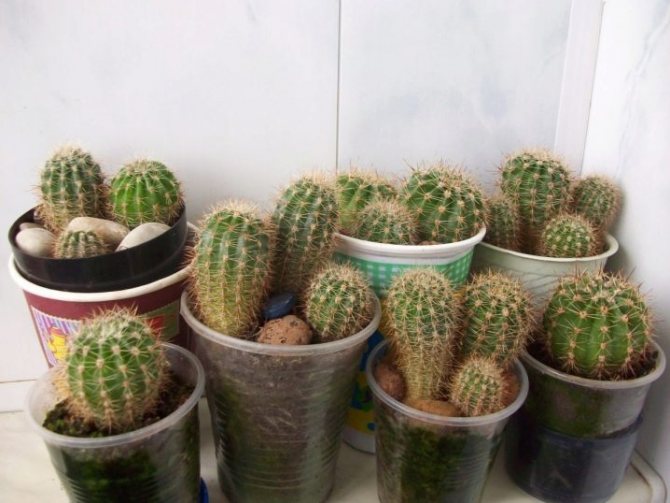

If the procedure is performed correctly, then very soon the "kids" will take root, after which they can be seated in more spacious containers.
The fact that the "baby" feels well after the transplant will be evidenced by her healthy appearance and gradual growth.
Cuttings
Types of cacti that do not form shoots are bred by cuttings. Only healthy and well-developed specimens are suitable for this method.
In this case, you can get a viable cutting by cutting off the top. Cutting is carried out with a tool with a sharp blade, pretreated with any alcohol-containing agent. The place of the cut on the plant and the cuttings is also disinfected.... Moreover, the cut of the cutting is additionally treated with a solution of a root formation stimulator.
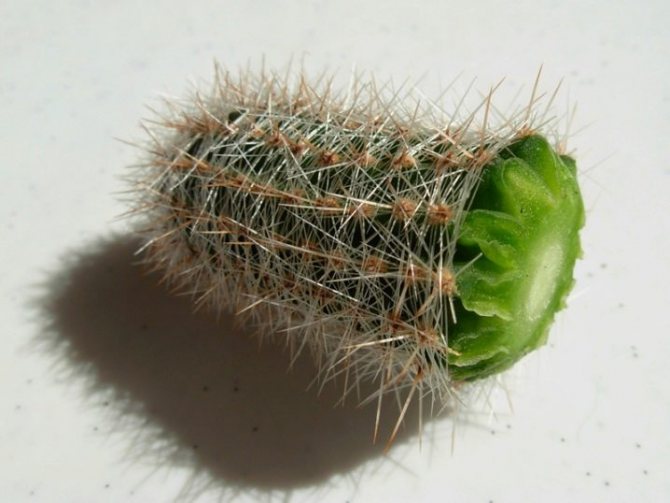

After cutting, you cannot immediately plant the cutting in the substrate. After processing the planting material with disinfecting and stimulating drugs, it is removed for several (5–6) days in a dry and dark place, fixing it in an upright position. This procedure is necessary so that the cut site can dry out a little. This is an important condition for the prevention of rot.
The planting of the cuttings is carried out in the same way as the planting of "children", lightly sprinkling the lower part. Cuttings that are too long are fixed on a wooden or plastic support. To root the apical part of the cactus, use the same composition of the substrate as in the case of planting the shoots.
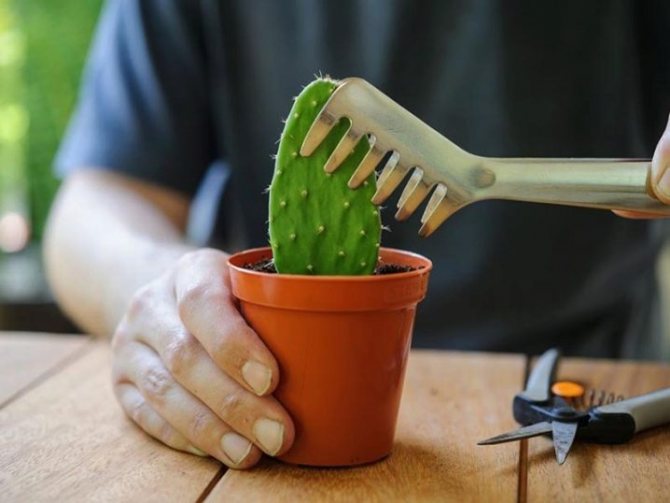

It is necessary to plant the cutting in the substrate vertically. This situation will prevent the massive formation of lateral roots and, as a result, the uneven development of the young plant.
Selection of soil and capacity
When propagating cacti, planting material often does not have roots, so the soil and flower pot must meet certain requirements for their appearance. The soil is prepared loose, well-drained, poorly nutritious. It is advisable to purchase a ready-made substrate for cacti and succulents in a specialized store. When compiling a soil mixture, you yourself should increase the initial amount of coarse-grained sand introduced. In addition to it, add garden and leaf land. For a more suitable structure, it is allowed to pour in some foam balls or small stones.
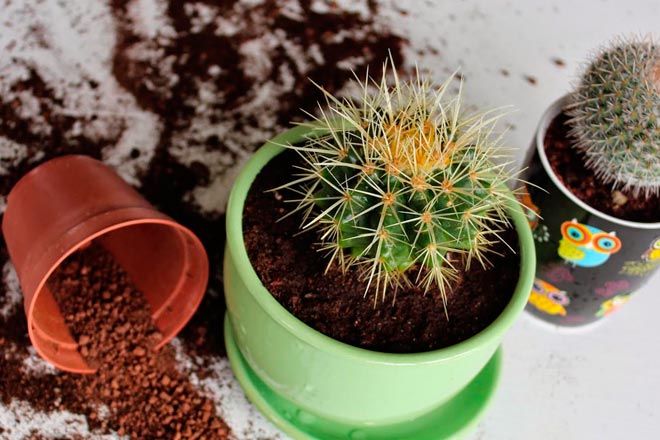

Natural materials must be pre-prepared by disinfecting with a solution of potassium permanganate or boiling water. River sand should be sieved, rinsed with hot water, and dried. Otherwise, it is possible to cement the substrate instead of imparting lightness and looseness. It is imperative to place a drainage layer on the bottom of the container. As long as the roots are absent or very small, expanded clay or other material can be poured up to half the volume of the container.
The cactus pot should be selected in accordance with the size of the root system. If it is absent, it is recommended to use small individual cups. The crockery material can be anything except iron. Most often, cultivation is carried out in a plastic or ceramic container. Preliminary preparation consists in washing with hot soapy water, rinsing thoroughly, processing with a solution of potassium permanganate and drying thoroughly.
Types of cacti
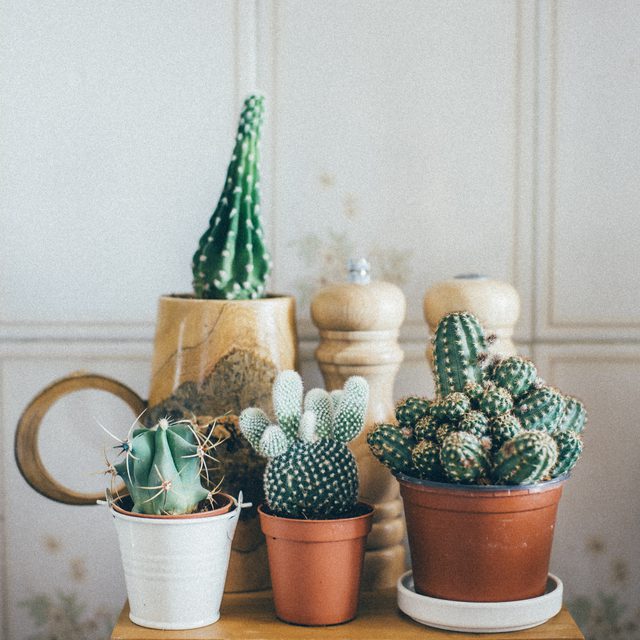

Let's dwell on this in more detail. The most popular types of cacti, photos and names of which can be found on resources of interest:
- Astrophytum: grows well enough. A distinctive feature of the culture is the presence of white flakes on the outside of the ribs. During flowering, beautiful yellow inflorescences are formed.
- Ferocactus: Has hard, long spines. Usually this type of cactus has a cylindrical shape. It can grow up to 5-6 inches in height. "Children" often appear near the main trunk. In summer, large flowers may appear on adult specimens.
- Opuntia: This type of cactus is distinguished by its unpretentiousness and rapid growth.It is important to use gloves when caring for this plant, as it has very sharp thorns. The peculiarity of this cactus is the presence of tiny spiny bristles all over the stem. They can be much more inconvenient than the needles themselves, since they are very difficult to notice. There are different types of prickly pear: flat, oval, and so on. These cacti are large in size. They bloom unusually effectively. They bear fruit with edible pear-shaped fruits. Plants are quite hardy and can be planted even outdoors.
- Echinocereus: Small spherical cacti covered in short spines. They bloom quite often with beautiful inflorescences. It is very easy to care for this type of cactus, therefore it is often recommended for beginners.
Instructions
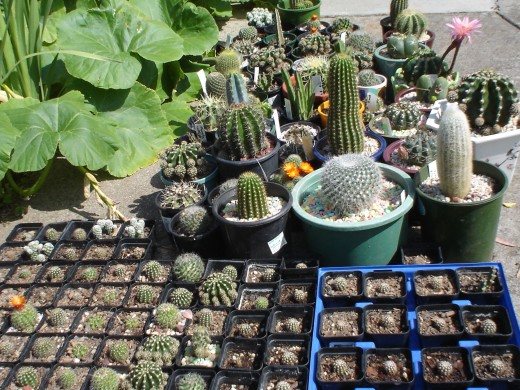

It is advisable to familiarize yourself with this aspect first of all. So how to split a cactus when transplanting? Many novice flower growers are afraid to carry out this procedure on their own, although there is nothing complicated in it. Let's consider in more detail how to transplant cactus shoots without roots.
It is better to use tweezers or a knife to separate the babies from the mother plant. It is especially important to consider this recommendation if you are going to plant a cactus with needles. Although the "babies" are not very firmly attached to the mother plant, the shoots should be removed with extreme caution. If the slightest particle remains in the cactus, it can lead to decay. As a result, the sprout will not take root.
It is better to prepare everything you need for planting in advance. These are the container, soil, drainage, scapula and the sprouts themselves. First, lay the drainage layer on the bottom of the container. The remaining space is covered with moistened soil. A small depression is made in the middle of the pot. The "baby" is placed in it without dropping it, cut downwards. If there are roots, then it is better to straighten them. Lightly crush the soil with your hands to anchor the young plant. Never bury the scion deep in the ground. To prevent moisture from evaporating too intensively from the surface of the soil, you can place sea pebbles and pebbles on top of it.
Suitable timing and recommended trimming frequency
Any procedures are more difficult for cactus to endure during the winter period, when they fall into a state of stagnation. Their rooting and recovery are slower, and due to a decrease in immunity, they are more often attacked by pests and get sick with infectious ailments.
But if hygienic manipulations can be planned at a more suitable time, then the sick succulent is cut off without delay. This is a compulsory measure. In other cases, pruning is desirable during the active growing season, that is, in spring and summer. Trimmed cuttings will take root faster, and the mother specimen will more easily undergo the operation and will not die.
It is interesting! Many growers advise pruning indoor flowers in the waning moon.
Most of these succulents do not require regular pruning. But, it depends on their variety and growth rate.
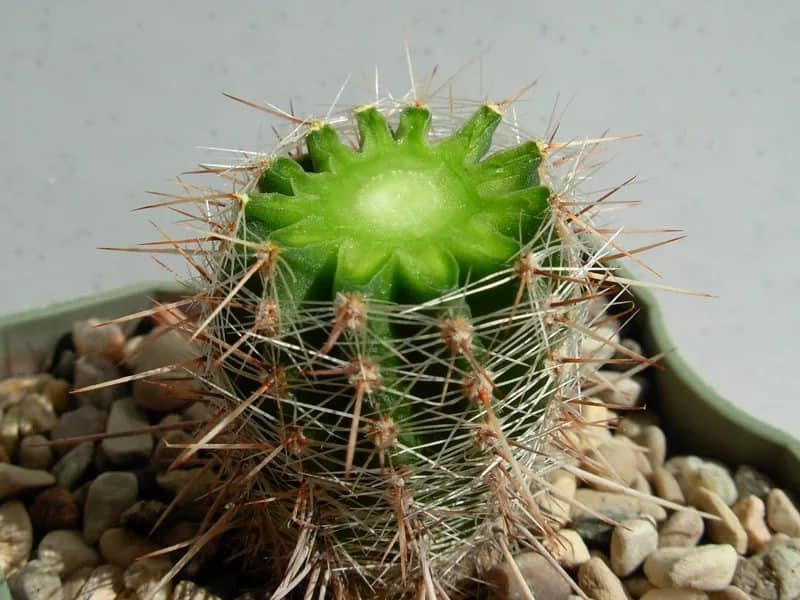

Seed method
The method is necessary for updating the collection, rejuvenating the existing copies. Over time, the breed degenerates, vegetatively obtained plants are less decorative, become sensitive to the effects of unfavorable factors. In this case, you need to plant the cactus with seeds.
Preliminary preparation consists in processing the planting material with a weak solution of potassium permanganate. It is permissible to soak the seeds in it for 8-10 hours. The capacity is used in total, filled with drainage, then 5 cm of a special substrate for cacti. Pour the soil with water with a temperature of + 40-45 ° C, wait until the excess drains into the pan, drain.
Prepare small holes with a toothpick or a match at a distance of 1.5-2 cm from each other. With tweezers, spread the processed and dried seeds into the holes.It is not required to fill up with sand or substrate. Cover the container with a bag or glass, transfer to a well-lit window sill, protecting it from direct sunlight. Maintain the temperature within + 22-25 ° C. The first shoots should appear in about a week, some varieties are able to germinate for 1-2 months. Gradually remove the shelter after the formation of the first thorns.
Preparation
- The day before sowing, the seeds should be soaked in a weak solution of potassium permanganate. The seeds can be purchased at any plant store.
- The sowing container must be washed with a strong solution of potassium permanganate or alcohol. It is important to make holes at the bottom to remove excess moisture.
- 2 weeks before sowing, the soil needs to be warmed up in an oven at 100 degrees for about 20 minutes. The soil should be porous and with the least amount of nutrients. Under these conditions, the roots of the plant will develop better. It can be a mixture of sand, peat, coal, etc.
All preparation steps are necessary for disinfection so that the soil and seeds do not become moldy.
How to choose and prepare land for planting?
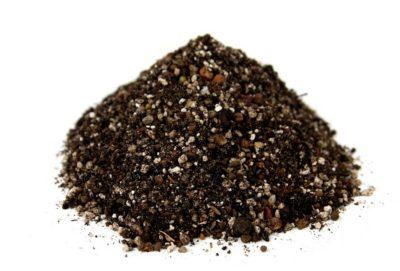

Unambiguously in ordinary land, a young plant cannot fully develop... Therefore, for planting, you must purchase a substrate in a specialized store. The packaging must be marked "For cacti and succulents."
You can make the necessary mixture with your own hands: mix 2 parts of river sand, 2 parts of garden soil, 1 part of peat. You can add some foam balls, ground eggshells in a coffee grinder.
A prerequisite for filling the container is the presence of drainage... It should occupy a volume equal to 1/2 - 1/5 of the pot.
What should be the pot?
You can plant a cactus in either a plastic or a clay container. Plastic does not absorb water and does not change the temperature of the soil; clay provides air access to the roots. Of course, the container should not be iron: corrosion will negatively affect the soil and the state of the root system. The main condition is that the pot must have drainage holes..
As for the size of the pot, then it is necessary to take into account the structure of the root system of each type of cactus. Holders of the rod system should be grown in deep and narrow pots, and shallow and branched ones in shallow and wide pots.
Features of the
Reproduction of cacti at home, most often, does not cause any particular difficulties. These unpretentious plants are appreciated by flower growers for their unpretentiousness to the conditions of maintenance and care. They also do not have special requirements for breeding and growing, so even an inexperienced florist can cope with these tasks.
However, the exotic origin of cacti, which come from South and North America, still dictates some conditions that must be observed when growing and propagating these plants. Failure to comply with these requirements can lead to diseases, poor survival and even death of flowers.
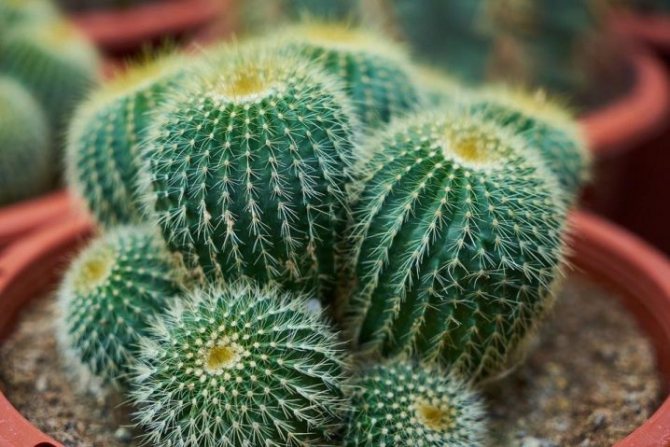

For the reproduction of these representatives of exotic flora, the following are usually used:
Certain varieties of cacti do not form shoots, therefore they can only be propagated by cuttings or by sowing seeds. Natural reproduction of cacti in the wild occurs precisely through seeds.
With regard to home conditions, this method is quite time consuming and difficult.
The simplest and most popular method of breeding these exotic plants involves the use of "babies" or offshoots. In the natural habitat of cacti, their reproduction by "children" takes place with the participation of wild animals. Thanks to the thorns abundantly dotting the surface of the "children", they, like a burdock, cling to the wool of the inhabitants of the savannas and prairies, after which they easily overcome considerable distances with them.
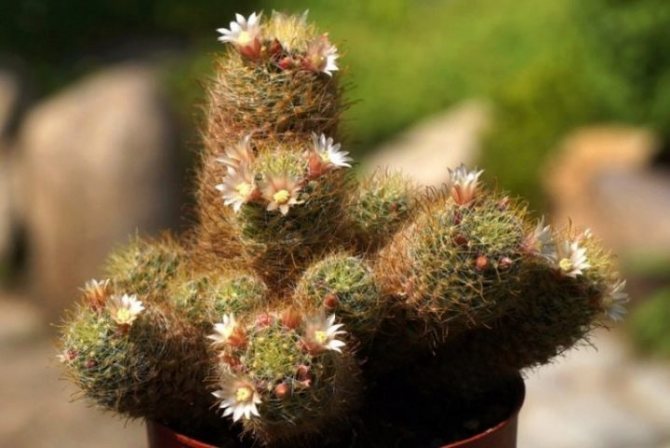

Even very small "babies" of cacti have the rudiments of roots, which ensure their quick survival when they get into wet and loose soil. Under favorable conditions, after a short time, a full-fledged adult plant develops from a small "baby".
The propagation of cacti by cuttings is usually resorted to in the case when, due to their species characteristics, the plants do not form "children", and it is impossible to get seeds from them. In this situation, cut stem fragments are used as planting material, which are rooted in the substrate.
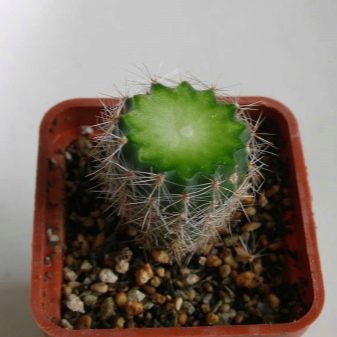

The most difficult way is considered breeding plants by grafting. This method is used in extreme cases - for example, when it is necessary to save a decaying flower. The grafting method is also used when breeding hybrids.
Read also Galanka to your home with your own hands
The most suitable periods for the propagation of cacti by shoots and cuttings are spring and summer. In these seasons, plants receive a sufficient amount of light and heat, and metabolic processes in their tissues are most active. Taken together, the presented factors determine the increased endurance and survival rate of young exotics.
It is best to start propagating plants by seeds in January-February. In this case, young seedlings, hatching from seeds, will have time to get stronger by the spring. With the arrival of heat, they will enter a phase of intensive development and will actively form the aboveground part and root system.
